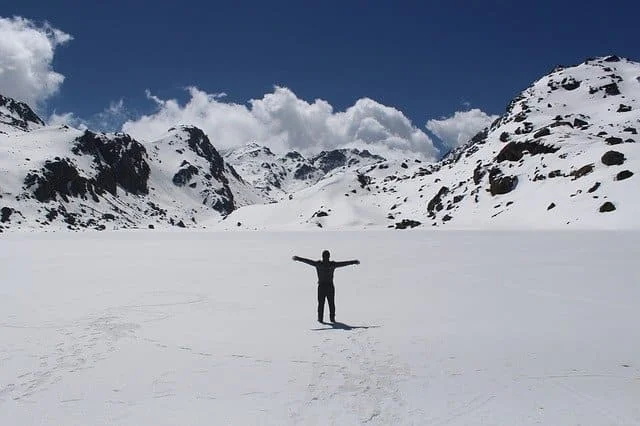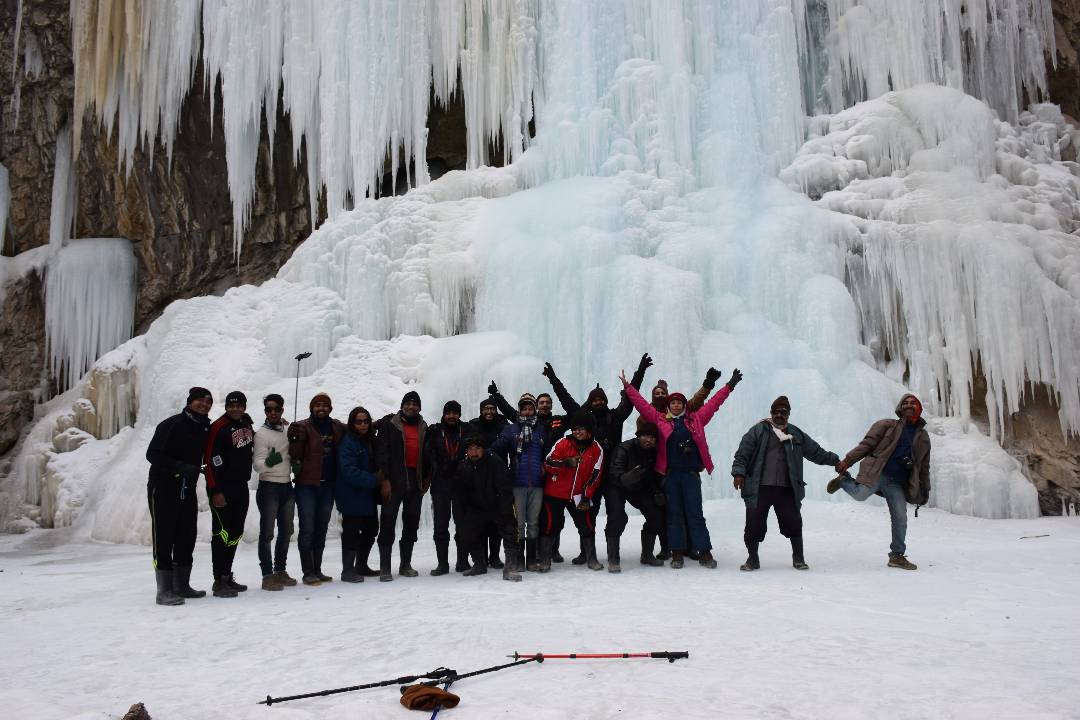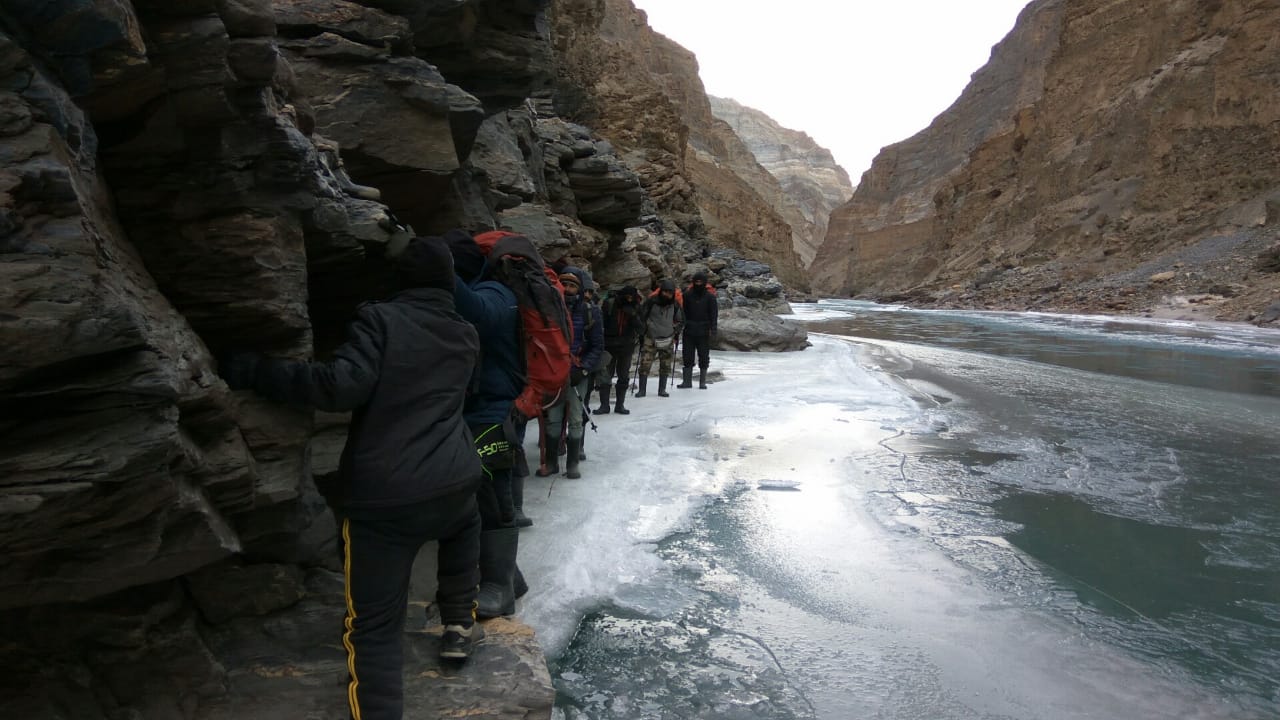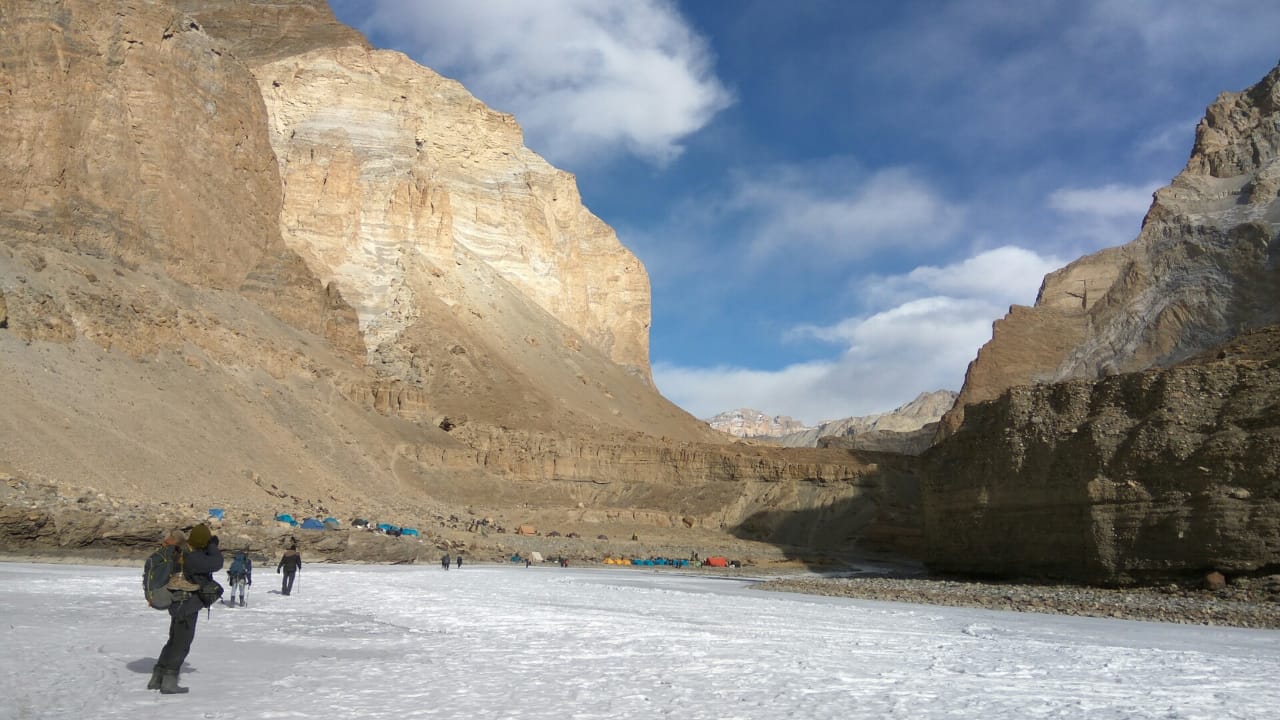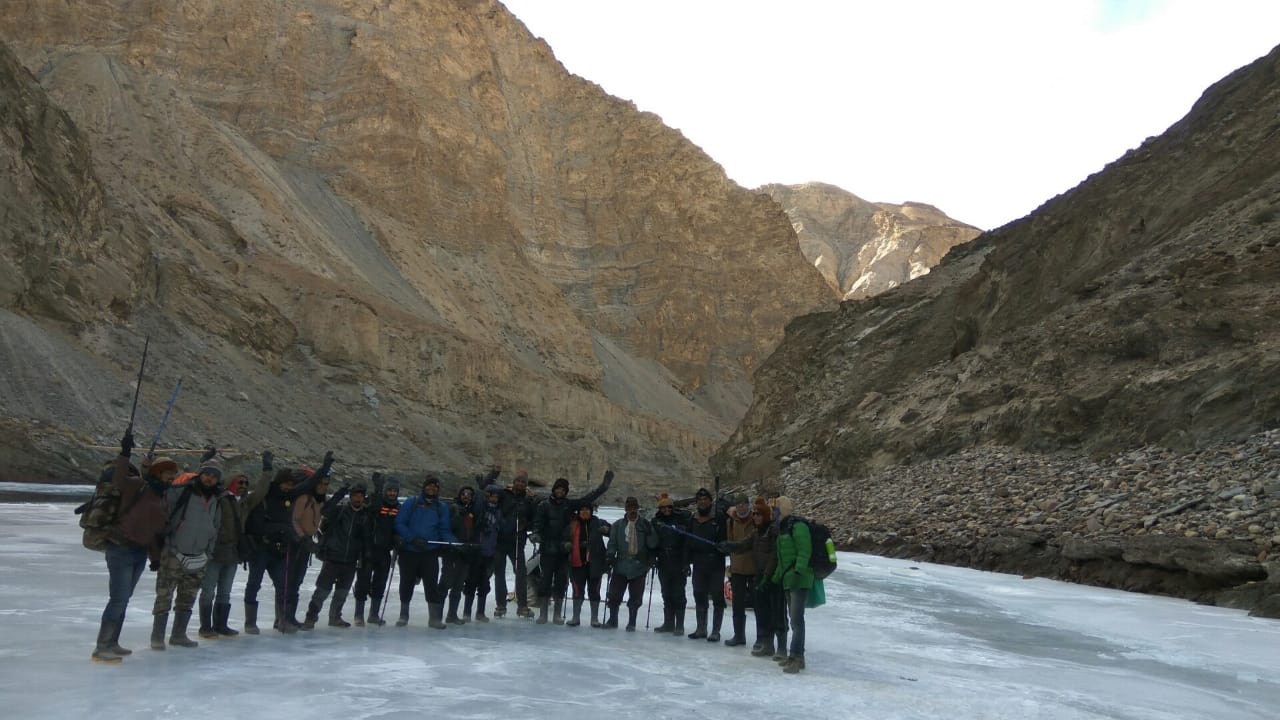Chadar Trek - Book Your Bucket List Adventure!
Starting from
₹
23125 ₹ 18500 +5% GST
25% OFF
-
9 Days11,100 ft.62 Km
-
DifficultLadakh
-
Best season : Jan, Feb
Add-ons
Trek Highlights
- Unique experience of trekking on the frozen Zanskar River.
- Amazing scenery, wild gorges and frozen waterfalls.
- It is an adventure-seeker's paradise.
- The frozen river which connects Zanskar valley to Ladakh.
- It's one of the thrilled and adventurous treks in India.
- The frozen river called Zanskar.
- Walking on an ice sheet is the most iconic thing one experience in the Chadar trek.
Inclusion/Exclusion
- Inclusion in cost during the trek:
- Airport Pick and Drop.
- Welcome & Greeting on Arrival at Guest House.
- Accommodation at Leh in Guest Houses on Double sharing basis on Day 1, Day 2, Day 3, and Day 8.
- Breakfast when in Leh on Day 4, and Day 9.
- Skilled local staff with years of experience in Chadar and Zanskar region.
- Transportation from Leh to road head on Day 4 and road head to Leh on Day 8 (Sharing basis).
- Vegetarian meals on the trek (Breakfast/Lunch/Dinner) starting on Day 4 Lunch to Day 8 Lunch.
- Hot water in buckets shall be provided on request while staying in Guest House in Leh.
- Stay in Alpine/Dome Tents on Double Sharing the basis on Day 4, Day 5, Day 6, and Day 7.
- Common Kitchen/Dining/Toilet tents will be used during the trek.
- Cooks/Helper and other requisite staff.
- Porters for carrying common equipments (like rations/tents/utensils/groceries).
- Double Layered sleeping bag and 1 inch sleeping mattress.
- Basic First aid Kit with a portable oxygen cylinder.
- The Facility of keeping extra luggage at Leh when leaving for the trek.
- Celebratory Team Dinner & certificate distribution on Day 8.
- Exclusion in cost during the trek:
- Mandatory GST of 5% on Invoice Amount.
- Any personal trekking gears – like Gum Boots, trekking poles or sleeping bag liners.
- Adventure insurance and the cost of emergency evacuation.
- Any personal expenses like purchases of beverages/bottled water /chocolates/dry fruits etc.
- Shared or Private Porters for carrying personal luggage.
- Room Heaters at Guest House/ Hotel in Leh.
- Cost of transport, meals and accommodation if in case you have to leave the trek in between and return to Leh before the scheduled arrival i.e. Day 8, due to any reason like accidental, personal or force majeure.
- Wildlife permit fee/Medical check-up & Rescue/ALTOA NOC Cost and Adventure Insurance; an approx. amount of 5,500/- (subject to change without prior notice)
- Anything other cost which is not mentioned in Inclusion.
Send me detailed itinerary on my whatsapp no. 
Trek Highlights
- Unique experience of trekking on the frozen Zanskar River.
- Amazing scenery, wild gorges and frozen waterfalls.
- It is an adventure-seeker's paradise.
- The frozen river which connects Zanskar valley to Ladakh.
- It's one of the thrilled and adventurous treks in India.
- The frozen river called Zanskar.
- Walking on an ice sheet is the most iconic thing one experience in the Chadar trek.
Inclusion/Exclusion
- Inclusion in cost during the trek:
- Airport Pick and Drop.
- Welcome & Greeting on Arrival at Guest House.
- Accommodation at Leh in Guest Houses on Double sharing basis on Day 1, Day 2, Day 3, and Day 8.
- Breakfast when in Leh on Day 4, and Day 9.
- Skilled local staff with years of experience in Chadar and Zanskar region.
- Transportation from Leh to road head on Day 4 and road head to Leh on Day 8 (Sharing basis).
- Vegetarian meals on the trek (Breakfast/Lunch/Dinner) starting on Day 4 Lunch to Day 8 Lunch.
- Hot water in buckets shall be provided on request while staying in Guest House in Leh.
- Stay in Alpine/Dome Tents on Double Sharing the basis on Day 4, Day 5, Day 6, and Day 7.
- Common Kitchen/Dining/Toilet tents will be used during the trek.
- Cooks/Helper and other requisite staff.
- Porters for carrying common equipments (like rations/tents/utensils/groceries).
- Double Layered sleeping bag and 1 inch sleeping mattress.
- Basic First aid Kit with a portable oxygen cylinder.
- The Facility of keeping extra luggage at Leh when leaving for the trek.
- Celebratory Team Dinner & certificate distribution on Day 8.
- Exclusion in cost during the trek:
- Mandatory GST of 5% on Invoice Amount.
- Any personal trekking gears – like Gum Boots, trekking poles or sleeping bag liners.
- Adventure insurance and the cost of emergency evacuation.
- Any personal expenses like purchases of beverages/bottled water /chocolates/dry fruits etc.
- Shared or Private Porters for carrying personal luggage.
- Room Heaters at Guest House/ Hotel in Leh.
- Cost of transport, meals and accommodation if in case you have to leave the trek in between and return to Leh before the scheduled arrival i.e. Day 8, due to any reason like accidental, personal or force majeure.
- Wildlife permit fee/Medical check-up & Rescue/ALTOA NOC Cost and Adventure Insurance; an approx. amount of 5,500/- (subject to change without prior notice)
- Anything other cost which is not mentioned in Inclusion.
Short Itinerary:
Day 1: Fly to Leh.
Day 2: Acclimatization in Leh (Rest/ Mild walk).
Day 3: In Leh (Get Medical, Insurance, Wildlife Permit and ALTOA NOC).
Day 4: Drive to Shingra Koma (Tsomo Paldar).
Day 5: Shingra Koma to Tibb Cave.
Day 6: Tibb cave to Naerak camp.
Day 7: Naerak to Tibb Cave.
Day 8: Tibb Cave to Shingra Koma and drive back to Leh.
Day 9: Return from Leh.
Available Departure Dates:
Dates 2023
Note: If you are more than 6 person you can ask for your preferred dates.
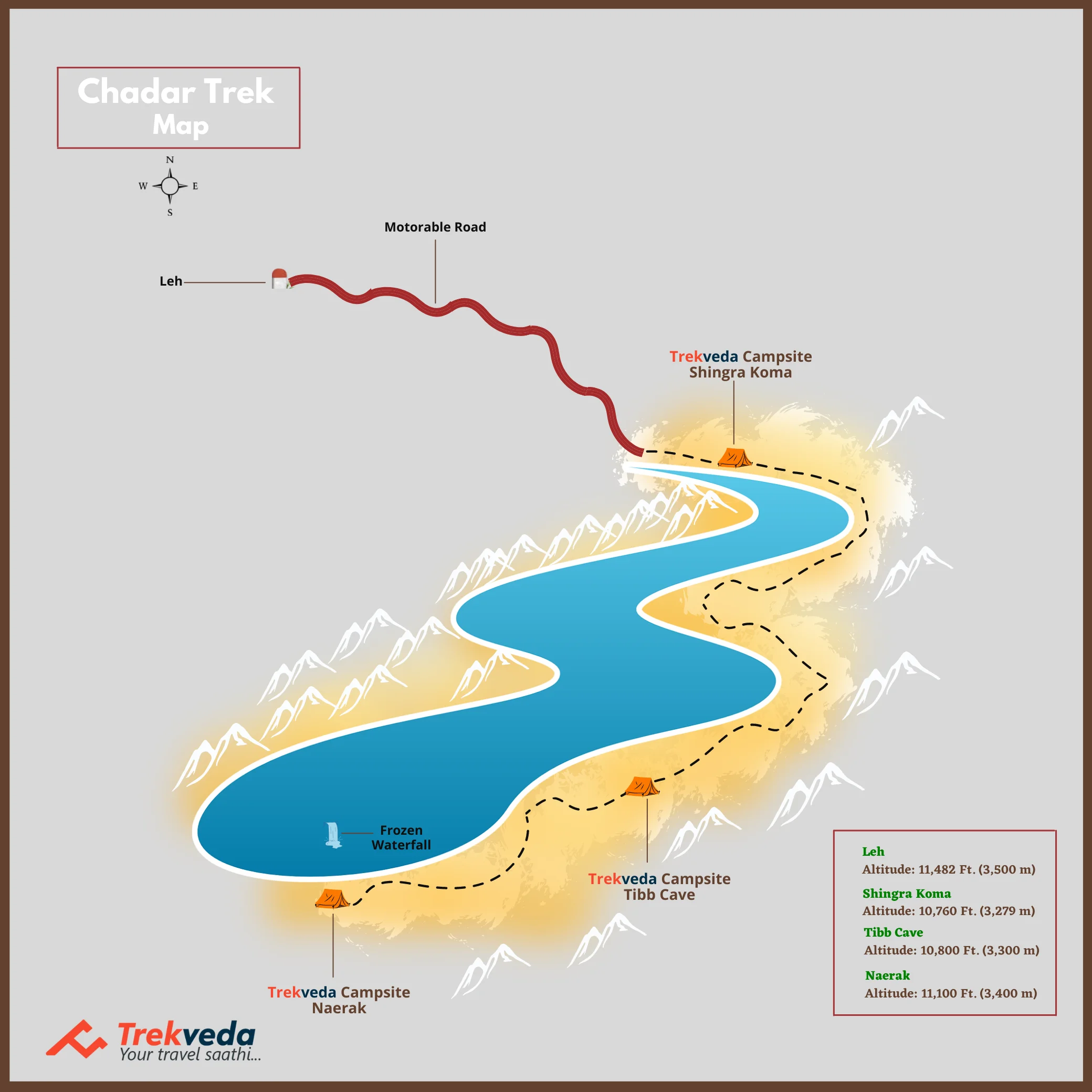
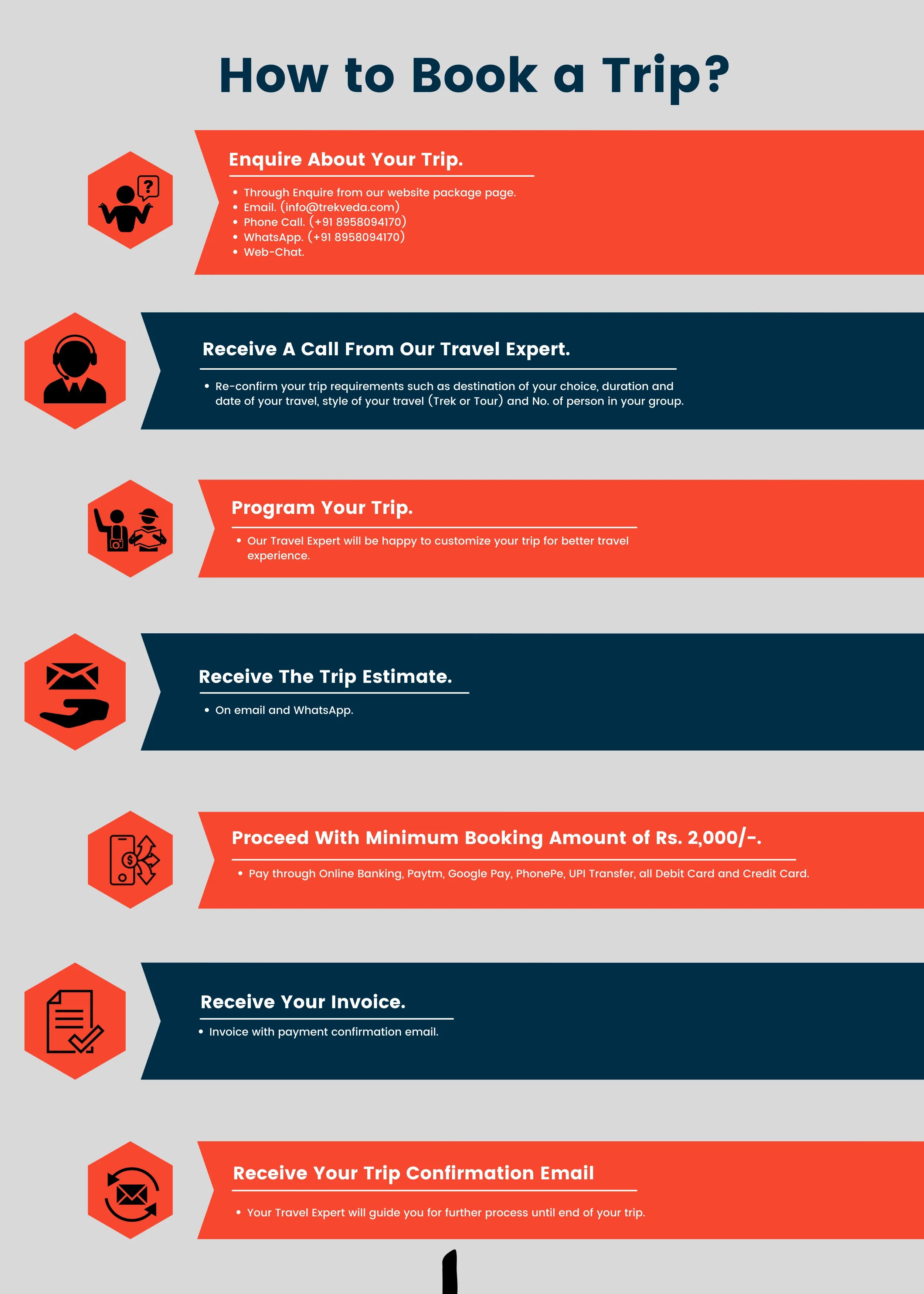
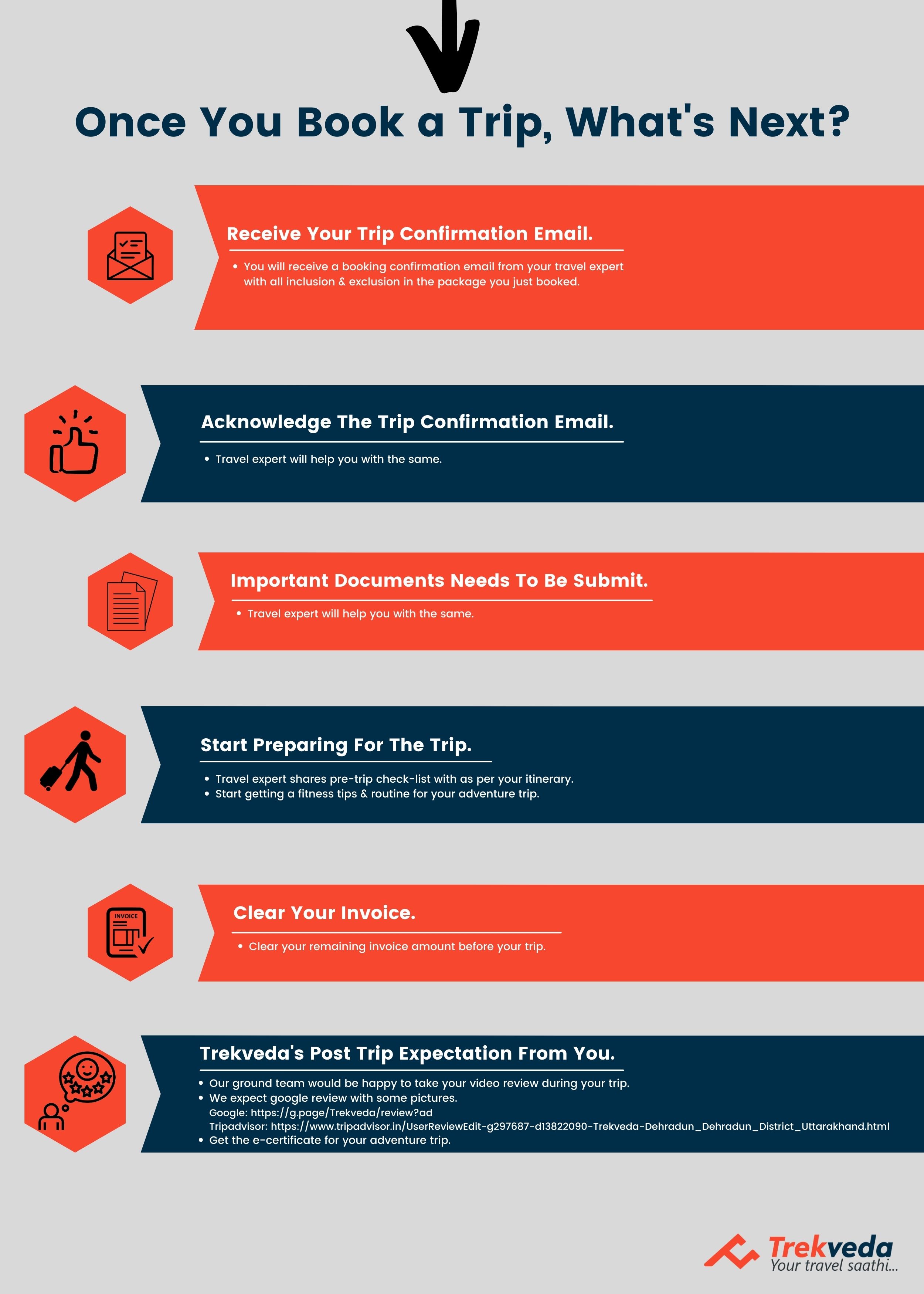
See Detailed Itinerary
The frozen Zanskar river Trek is the chadar trek Ladakh and its main attraction is the frozen river of Zanskar made from the ice sheet. It connects Ladakh to Zanskar and takes place on a trade route used by indigenous people for centuries. The chadar trek Ladakh is perfect for people who want a thrilling winter experience like never before. The frozen lake trek in Ladakh is one of the most popular ways to experience a completely different side of this region.
Chadar Trek is one of the most thrilling and adventurous treks in India. The frozen Zanskar River provides endless opportunities for camping and skiing. Chadar Trek is one of the most popular adventure activities for tourists visiting Ladakh can witness the beautiful view of photography.
Chadar Trek best time is from January to February when the frozen Zanskar river freezes into an ice sheet. The campsite at Nerak will be the coldest of all on the trek, with temperatures dropping as low as -30 degrees during the night.
The thrilling walk becomes challenging for trekkers when the frozen Zanskar river freezes over. Though treks in India are well known, Trekking in Jammu and Kashmir like the chadar trek Ladakh is one of the most beautiful treks, as you walk on the frozen river. The Chadar Trek best time is mid-January to end-February when most groups trek the frozen river in their Chadar Trek packages.
What makes this Trek Different?
Walking on an ice sheet is the most iconic thing one experiences in the chadar trek Ladakh. In the world of trekking where you do summit treks, and ridge treks amongst those you get the chance to walk the ice sheet, a frozen Lake trek in Zanskar valley. The culture of Ladakh and the life of people beyond the modern era are so dynamic that make this trek a different one.
Difficulty Level : Chadar Trek
Trekking in Jammu and Kashmir like the Chadar trek is that it's not easy to get accustomed to the harsh climate, which turns the trekkers' exhaustion. Therefore there is a need for high endurance and expertise while picking the Chadar Trek package.
Highest Altitude : Chadar Trek
The highest altitude of the Chadar Trek is 11,123 Ft. this is the average highest, but the trekking is so tricky because of the climate condition of the trek.
Is it suitable for Children's?
No, trekking is not for children because of its high altitude and temperature condition. Therefore Chadar Trek package is not for Children.
Season : Chadar Trek
The best time for the Chadar Trek package is between mid of January and early February.
Trek Itinerary : Chadar Trek
Day 1: Fly to Leh.
Altitude 11,400 ft.
Stay in guest house.
Keep your woollen cap and gloves handy.
Landing in Leh at the 22nd highest commercial airport in the world which is “Kushok Bakula Rimpochee” airport; The airport is named after 19th Kushok Bakula Rinpoche, an Indian statesman and monk, whose Spituk Monastery is in direct vicinity to the airfield. Where our guide will pick you up from the airport and you will be heading to guesthouse, throughout the way you will get the idea about the lethal temperature with push back air flow; after reaching to the guest house you can freshen up yourself and can get all the essential equipments and cloths for trekking. There is a market called “Old Tibetan refugee market” which can help you to make your mood relax, and after all over the market session; you will get back to the guest house before the sun goes down as per our safety norms.
Day 2: Acclimatization in Leh (Rest/ Mild walk).
All the health-related issues that trekkers can face, as per the new regulations applied by Ladakh Government Authorities, this acclimatization is giving to the trekkers so that anyone doing the Chadar Trek should be at least spend one day in Leh to get their body used to of the weather conditions here, every trekker strictly follows that. You can spend the day shopping at the Leh market. It is essential that you get used to the cold temperature in Leh because the frosty weather will only tend to fall as you start walking on the frozen Zanskar.
Day 3: In Leh (Get Medical, Insurance, Wildlife Permit and ALTOA NOC).
Basically, it’s a day where we provide expertise guide along with local people to give you a brief about the trek. At least you’ll get mentally as well as physically prepare for every situation; even though we provide medical check-up to make sure whether you are fit for the trek or not. You can do some exercises which help you to get fit for the trek. Sightseeing would be a good idea to get habitual with temperature but only in the daytime, you need to come back to Gust house before sunset. Alcohol and smoking are prohibited during a trek along with camp and guest house area as per our safety norms.
Day 4: Drive to Shingra Koma (Tsomo Paldar).
Altitude : 10,390 to 10,550 ft.
Trek Distance : 10 km
The day will start with some challenging steps like to get out of your comfortable and cozy shelter but you have come so far where Cristal white Chadar will be waiting for you to take away on it, mind your steps on snow bail roads because you will not be familiar as much as localities are. You’ll drive till Nimu where Indus & Zanskar meets, military sub area with some Bourg houses shut down the cause of weather. This day will cover 10 km at least; while walking on the side of Chadar and glimpses of slush appear to keep drift away with the flow. After an hour you’ll be in Tilat Sumdo; this will be the very 1st place where you can see Tibetan tribes people. Singra Koma is 9.5 km from this place; an average trekker takes 6 hours to reach. After a bit, you’ll get used to of walking on Chadar, it’s like a nature treating you with skating adventure. Camp food after fatigue day will make your mood on; at the parabola edge exactly bang on the river Gyalpo is located. It seems handmade white frost spread around; humongous trail will make you feel safe and protected. After night meal retains your only liveliness in trek and inverts from stockpile for next day.
Day 5: Shingra Koma to Tibb Cave.
Altitude : 10,550 to 10,760 ft.
Trek Distance : 15 km
Applause yourself for the next day with a bed tea in the early morning, after having breakfast we’ll move towards Tibb cave. Eat well it gives you the energy to walk; even though walk makes your body warmer than meals but still for safety purposes, as well as for this day because the day will be the harder than the previous one and here you walk around 15 K.M. at least. Through gulches of Zanskar will seem more beautiful and adventurous. While walking on the way tunnels will be visible, it seems rock solid with ice pelted. In mid-way, frozen waterfall reminds you-you're all Disney cartoons from childhood because the waterfall will be big from one another. Crossing up the frozen waterfall, you cannot miss the chance to show your photography talent here and it will compliment your talent perfectly. Tibb cave is a gift from Zanskar valley to Tibetan carriers. Butter tea, also known as Po cha will surprise you with the texture of teapot; it will help your healing chapped lips.
Day 6: Tibb cave to Naerak camp.
Altitude : 10,760 to 11,150 ft.
Trek distance : 12.5 km
Attraction : Frozen waterfall
Yesterday’s curiosity will be there about frozen waterfall because the big one is about to come. It’s a perfect example of witchcraft of nature where several colors are spreading all around; it’s more like a piece of glass made by nature I would rather say. Getting after the source of energy through the day meal you can say, the Skycaps Mountains seems to be struggling with the sunlight. The only thing which connects the river to the valley is the bridge which you can see only in summers. Outstretch tent will prepare night meal for you till then if you want to get colored into Zanskari life you can. You’ll forget your 12.5 km journey in just a few moments.
Day 7: Naerak to Tibb Cave.
Altitude : 11,150 to 10,760 ft.
Trek distance : 12.5 km
The day is about going back to Tibb Cave, but this is not too easy to do. Cause temperature will surprise you all the time till morning to sunset. On the way you’ll get the glimpses of nostalgic memory where u had struggle to reach there and some clicks on your mind, the local people fresh up your memory more when they come back from Leh to their villages. Kind of positive and to be a happy kind of attitude will make you feel if they can why don’t you. Name of some Zanskari lifestyle fatter getting yesterday’s session; you’ll automatically speak like Goucha (Woolen robe) and colorful sash Schrage.
Day 8: Tibb Cave to Shingra Koma and drive back to Leh.
Altitude : 10,760 to 10,550 ft.
Trek distance : 15 km.
From the home of Tibetan, carriers will be a bit nostalgic. The day will start towards Shingra Koma, the humongous trail with white coated Gyalpo seems to be reachable after an hour, but it’s not. Because we have to cover around 15 km or more than that as you already saw and got the idea about Gyalpo it’s a summit of the enormous mound, so it will be such a great thing to be the part of an indelible moment. Some descry feeling can get you some Himalayan animals.
Day 9: Return from Leh.
After departing from Leh this journey will remind you always be the part of the land beyond the world but located in J&K. The people are behind the wall of snow, Brave Zanskaien I must say, that innocent smile overlaps your smile when you ever think about your Chadar trek experience. Respect comes from the heart for the people from Ladakh valley to be so Patriotic for their land. Linguistically they are different but they are more prominence than anyone because nature blesses them well.
Chadar Trek: Essentials
Trekking, no doubt, is one of the most thrilling adventure one could ever have in his/her life. With an elegance of nature and unmatchable experience of the pristine mountain ranges, trekking stands out among all the adventures across the world, but nothing comes free, there are certain aspects of the trekking which one needs to consider while he/she is making up his/her mind for trekking. Here’s a list of some basic requirements which one would need during his/her camp trekking. Let’s pay some heed to these prerequisites for trekking.
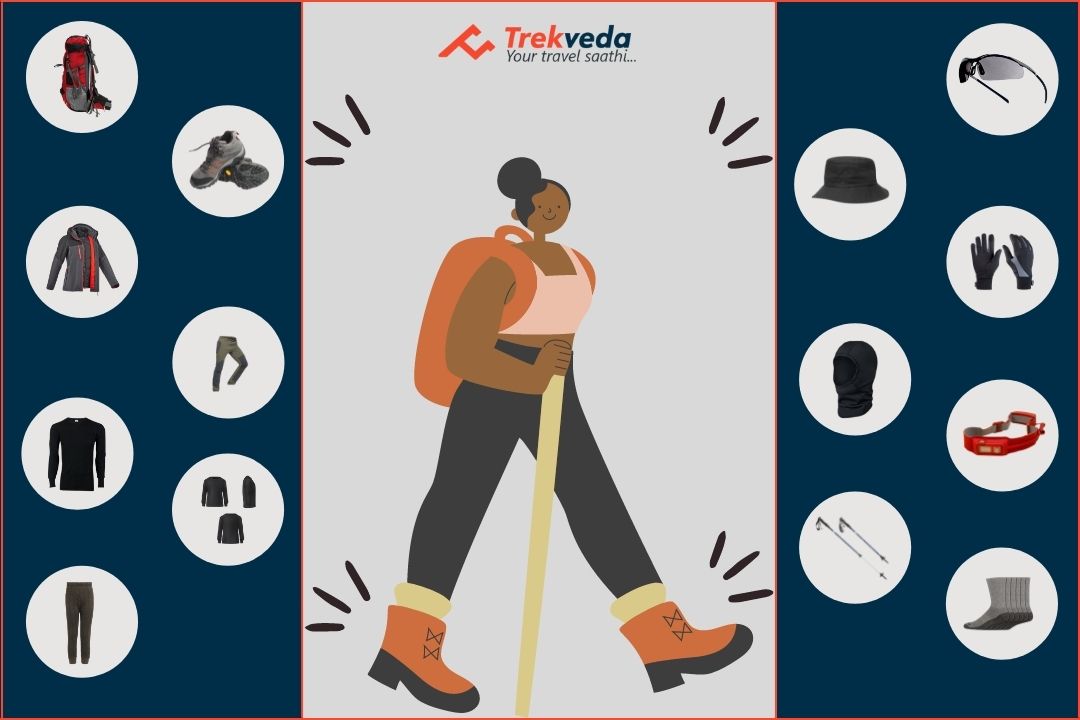
Things You Can’t Afford Missing On Trek
1. A Sturdy Backpack/RukSack
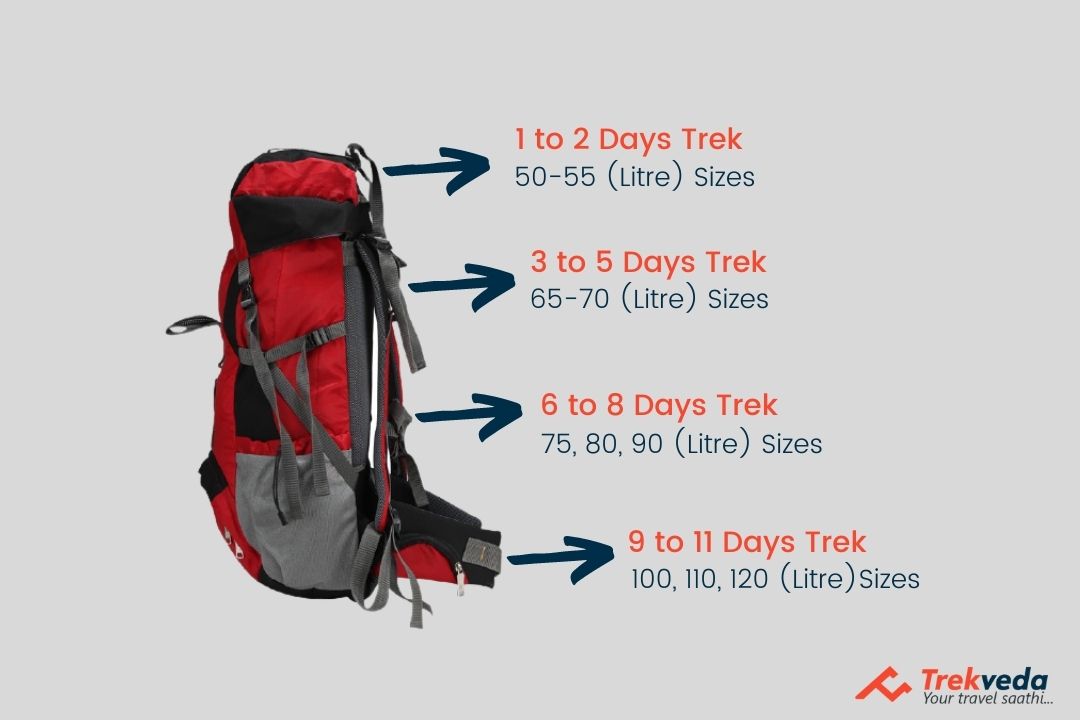
A high-quality backpack with an ease of carrying facility with durable and stern straps is one of the pivotal thing that you’d need during the entire trekking. The easier it’s to carry, the more fun you can have during your trek.
2. A Pair of Trekking Shoes
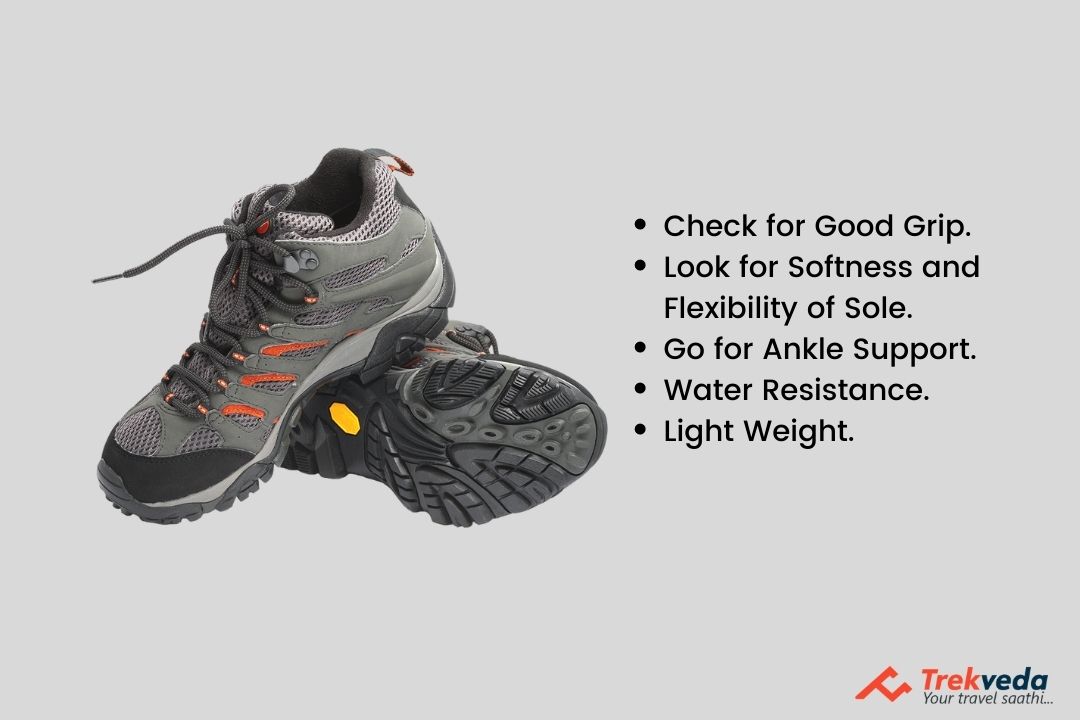
Your regular sports shoes can be a mess during the trek and one of the most regretting thing that might take away the joy of trekking. To prevent yourself from slippery patches through the streams, a pair of trekking shoes with good grip would do a great work for you and reciprocate your experience of trekking to the manifolds.
Clothing
Clothing is one of the most important aspect of trekking but that doesn’t imply the “what if situation”, hence carry the clothes that you’d need normally. Carrying more and more clothes will only add the weight, thus problem. Once on the trek, you’d not generally need to change the clothes every now and then, provided if you maintain your hygiene properly.
Three Warm Layers Jacket
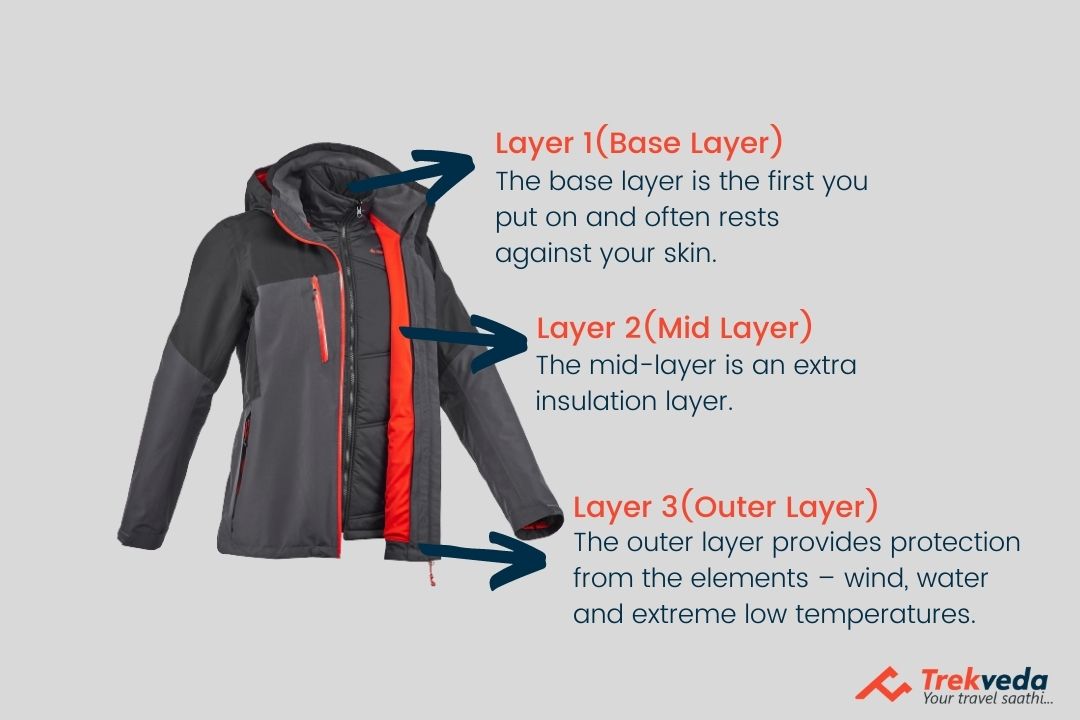
On high altitude treks, temperature after the sunset drops to the considerable degrees. So during these campsites, you might need an additional layer along with the padded jacket coupled up with a fleece and a warmer.
Trek Pants
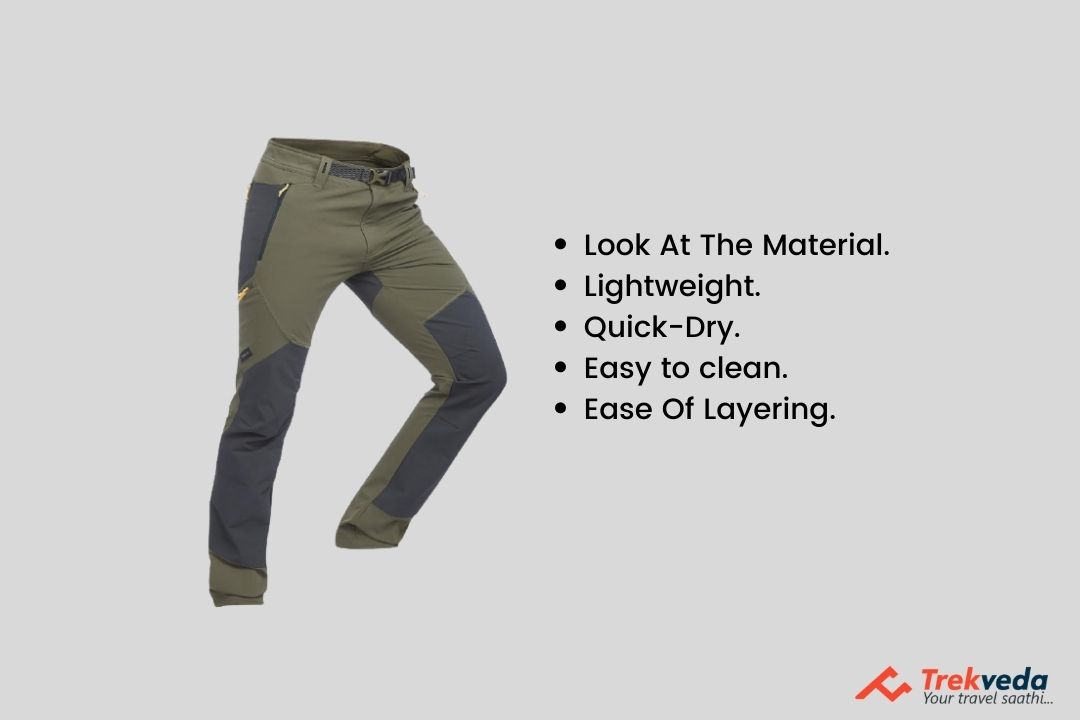
Please don’t go for jeans/ denims for the substitute for the trek pants since they’d not add comfort to your stay at the campsites. Wear one pair and carry the remaining two.
T-Shirts
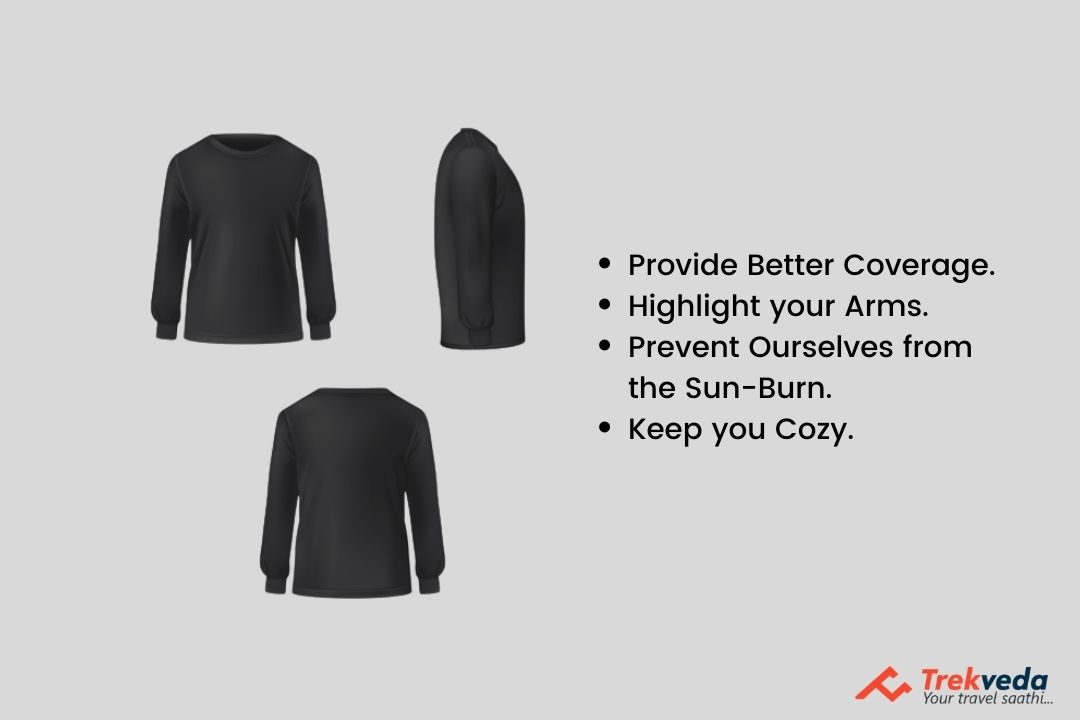
It’s advised to wear full sleeved t-shirts in order to prevent ourselves from the sun-burn. Carrying a dry-fit t-shirt or two can be a wise idea if you’re trekking during the rainy season. Regardless of the cold weather, trekkers’ bodies tend to sweat and to prevent yourself from falling ill, you’re advised to change your clothes at campsites.
Warmers
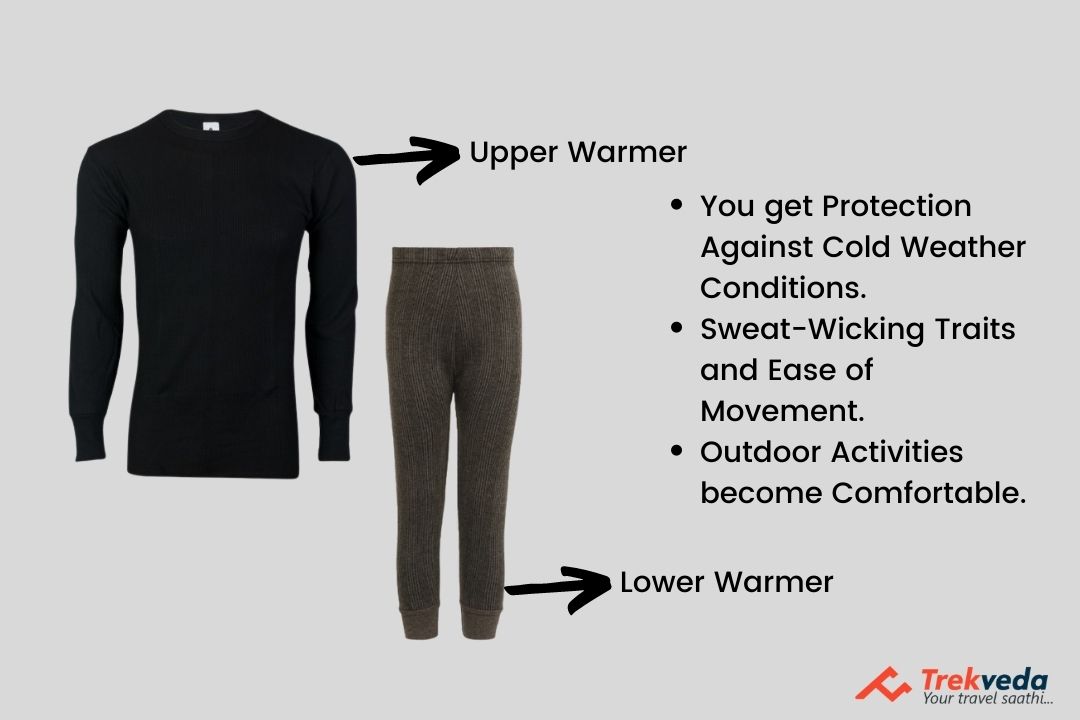
Warmers or thermals can be added on one’s own concern related to their health and their exposure to the cold climate.
Accessories
Shades
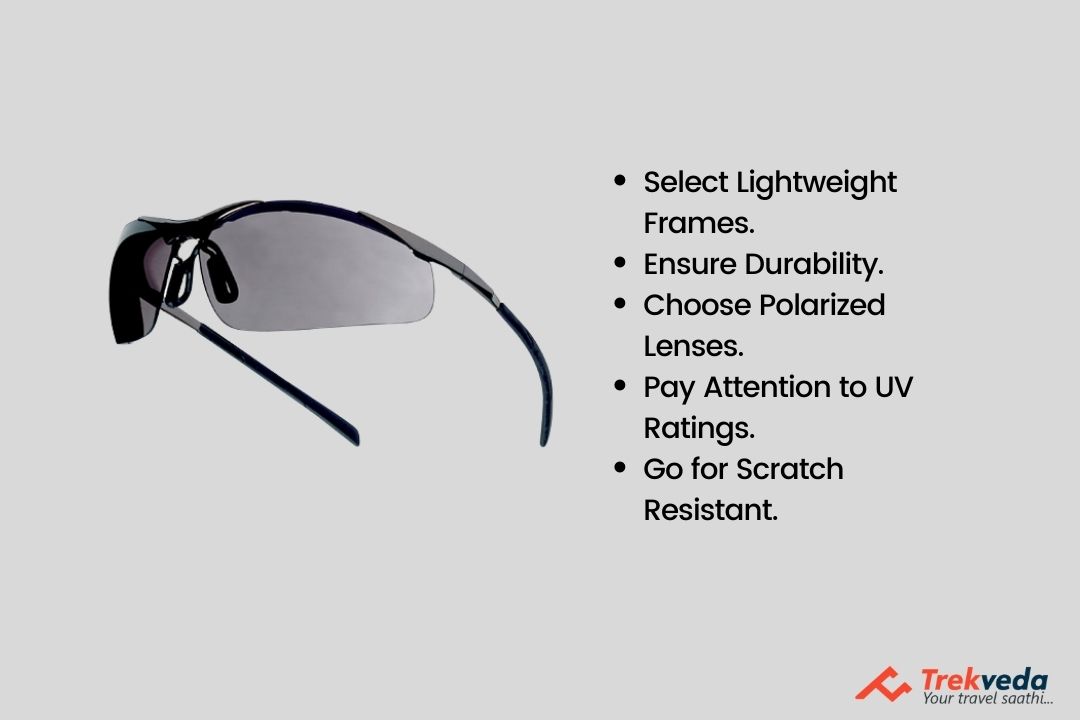
Sunglasses are to counteract snow visual deficiency. While at the same time you're probably not going to discover snow in October, convey a couple in any case.
Sun Cap
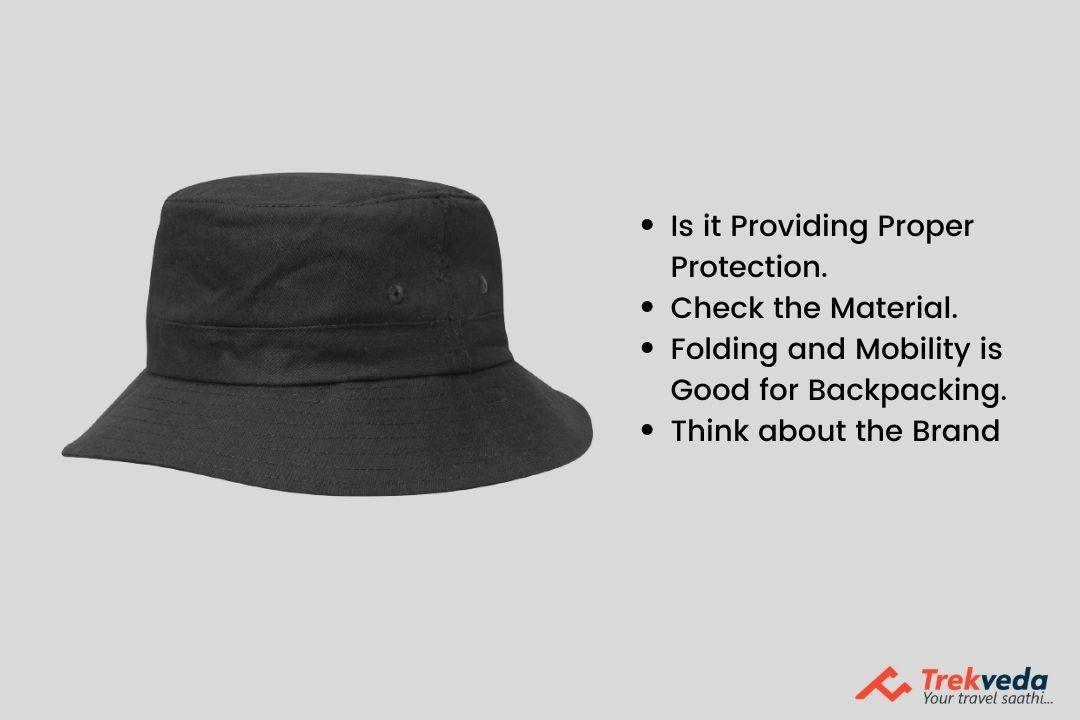
The sun feels more grounded while at the same time strolling on the mountain slants. Convey a sun cap to shield your head and neck from the warmth, particularly in case you're trekking later in the day.
Engineered Hand Gloves
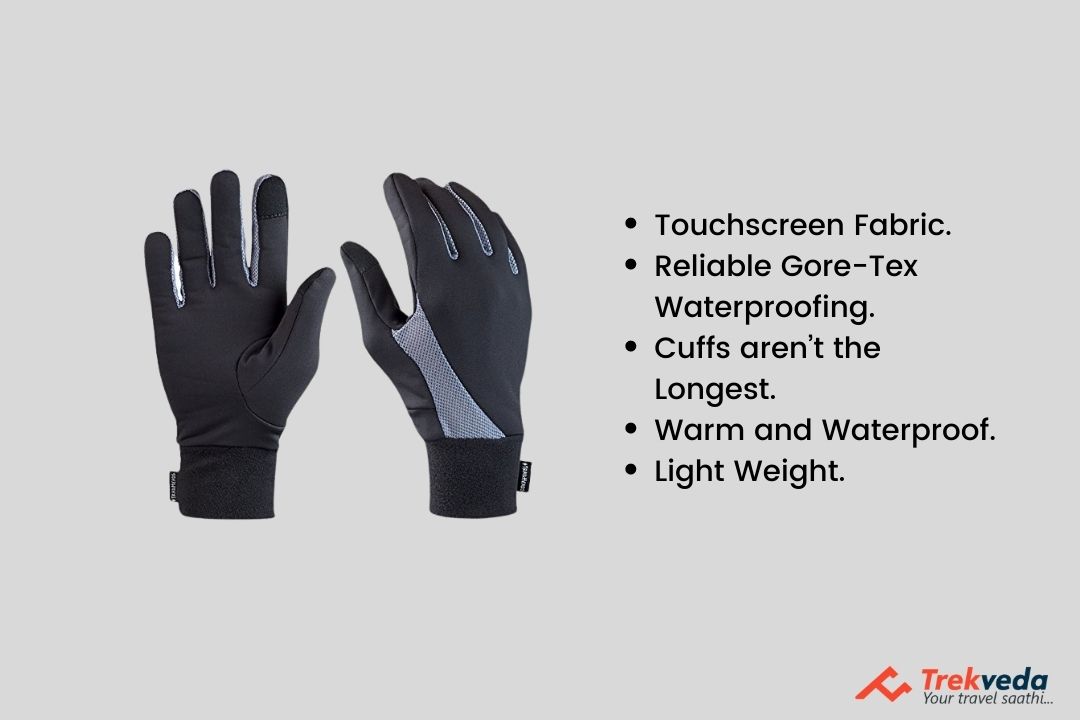
One sets of downy or woolen hand gloves. One sets of water evidence/safe, wind verification gloves.
Balaclava
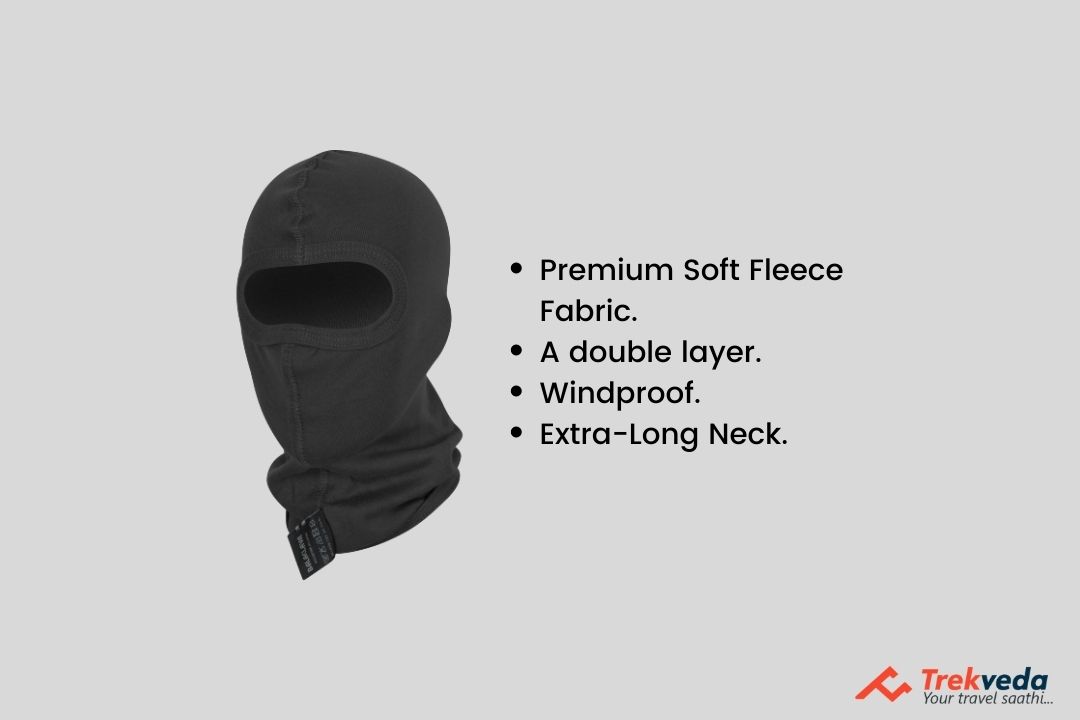
You may utilize woolen scarves rather too.
Socks

A part from two sports socks, you can take a couple of woolen socks for the night as they’d spare you from the dripping temperature.
Headlamp/LED Burn
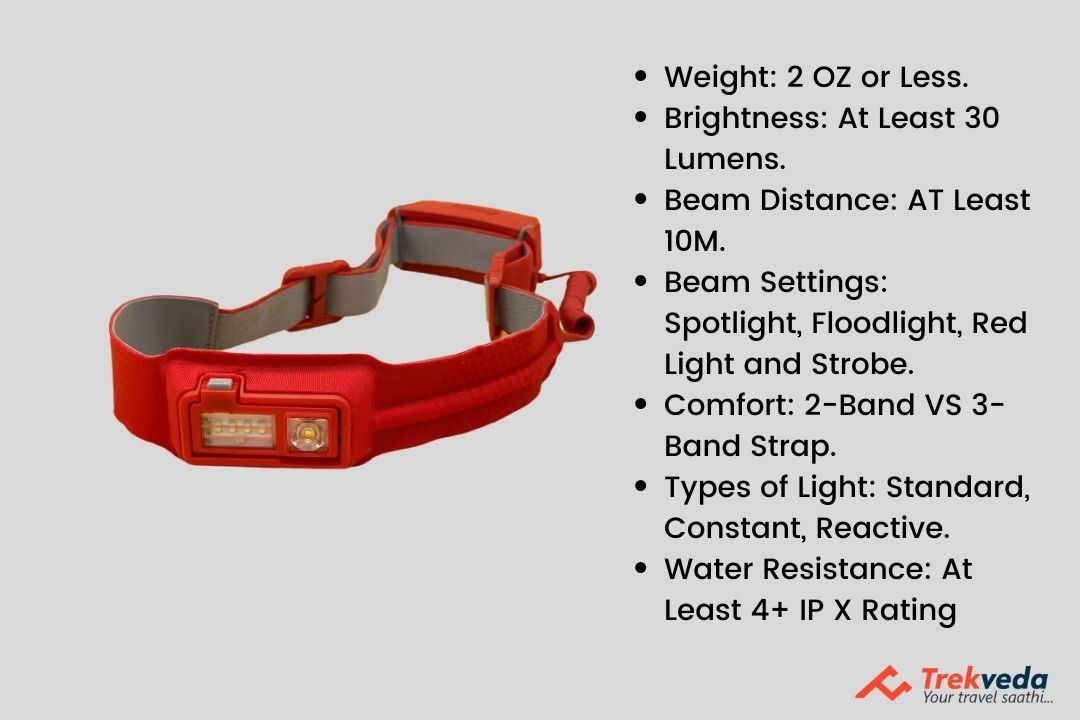
Mandatory
Trekking Pole
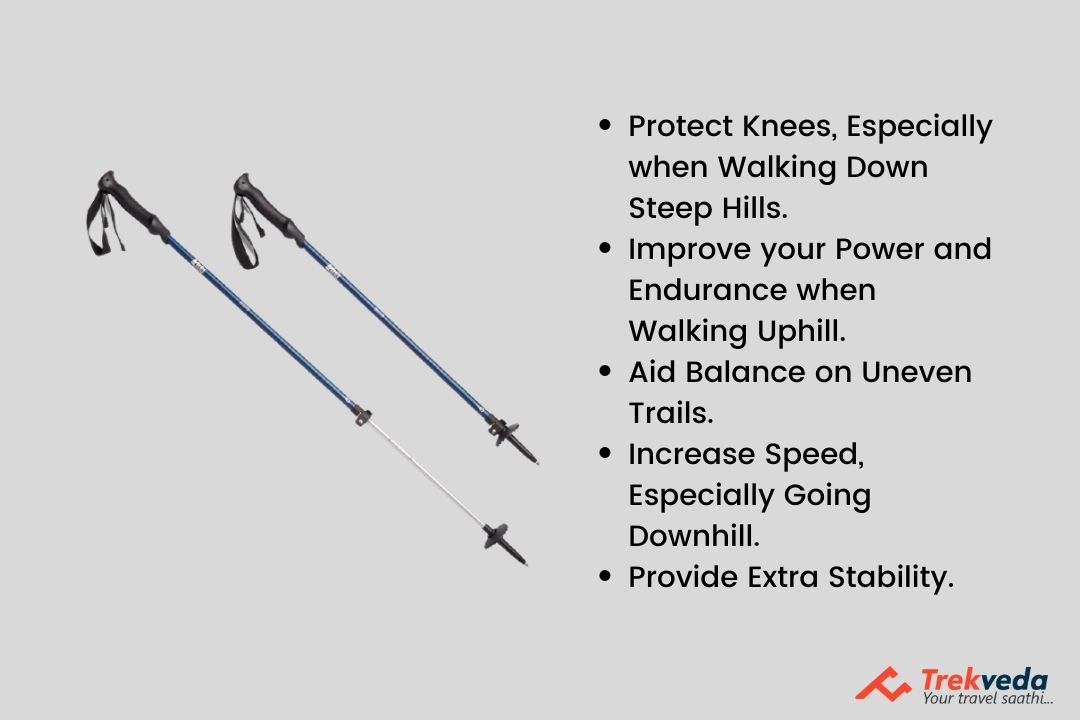
Having a trekking pole in your hand during the trek is boon, although at times it may bother you as an unnecessary article but it proves out most handy during the submit as it curbs your effort of straight inclinations of the high altitudes which often turns out tiring.
Other Essentials to Carry
An Additional Pack: This is one of the best practice you can do on one-day submits or treks where you need to get back to your campsite by the end of the day. Here you can pack your essentials like, water bottle, medical aids and snacks. This keeps you away from carrying the unnecessary weight.
Toiletries
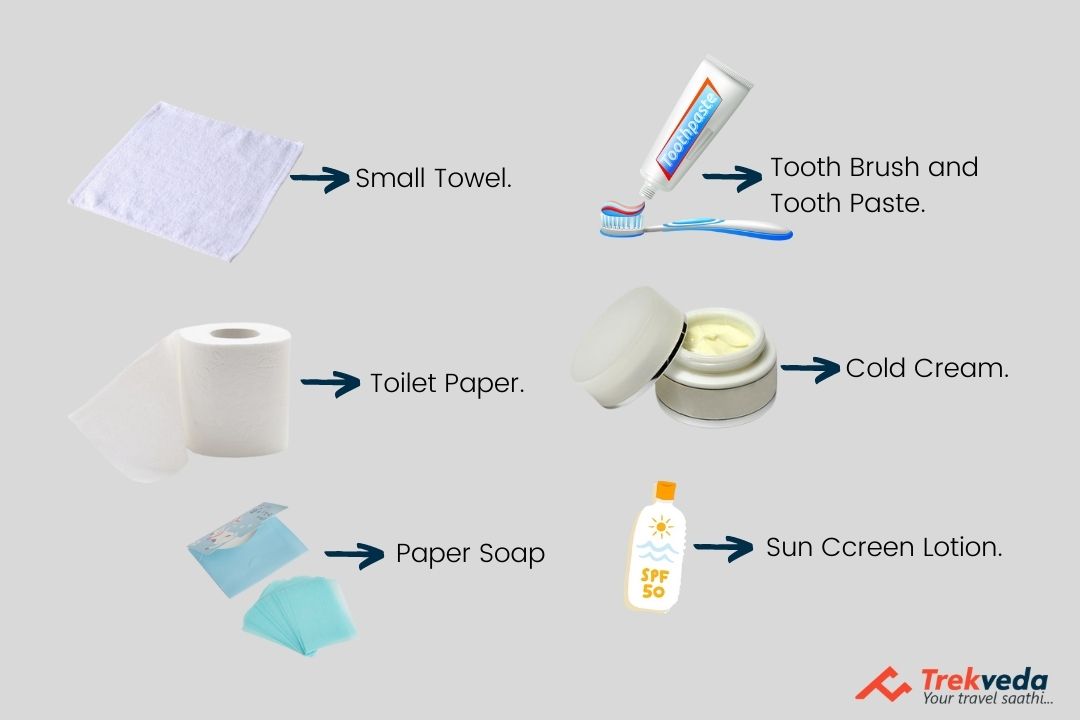
Be wise while choosing your cosmetic needs and daily use products. Refrain from using the non-biodegradable products, if you do so then make sure that you leave residue on the mountains. Always carry a zip bag to put such piece of stuff after use. Sanitary napkins also needs to be treated in the same manner.
Indispensable Water Bottles
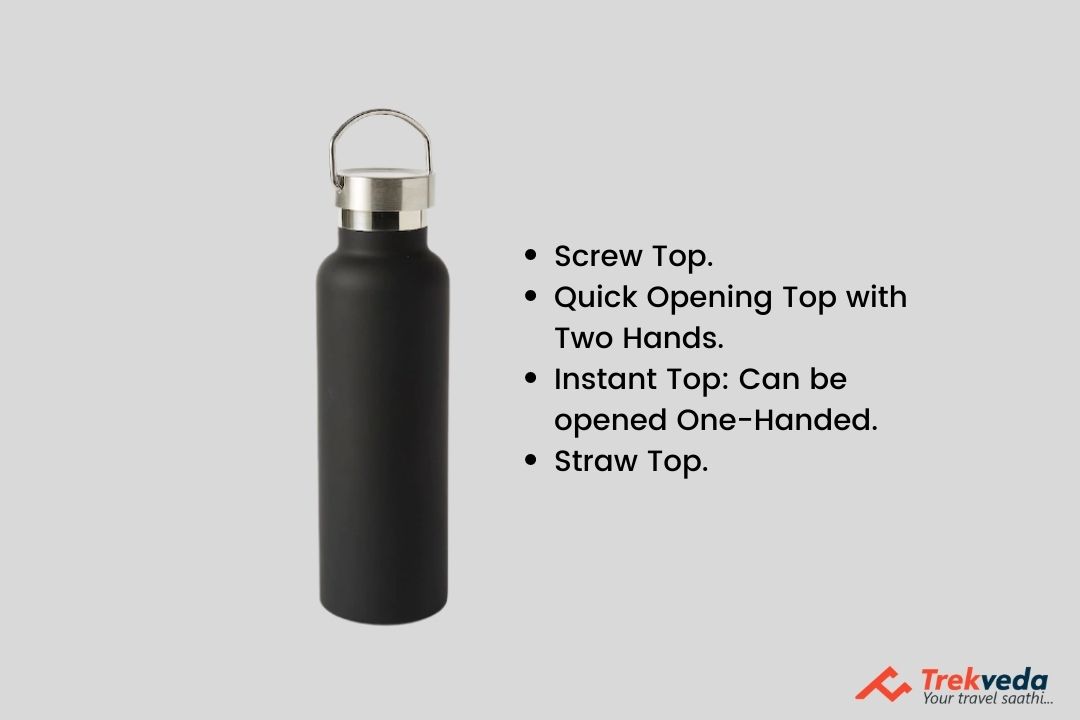
To keep your body hydrated during the trek, you are advised to carry your own water bottles during the treks since leaving plastic and its product is not advised on the mountains since they are not suitable for the environment of the altitudes.
Plastic Bags
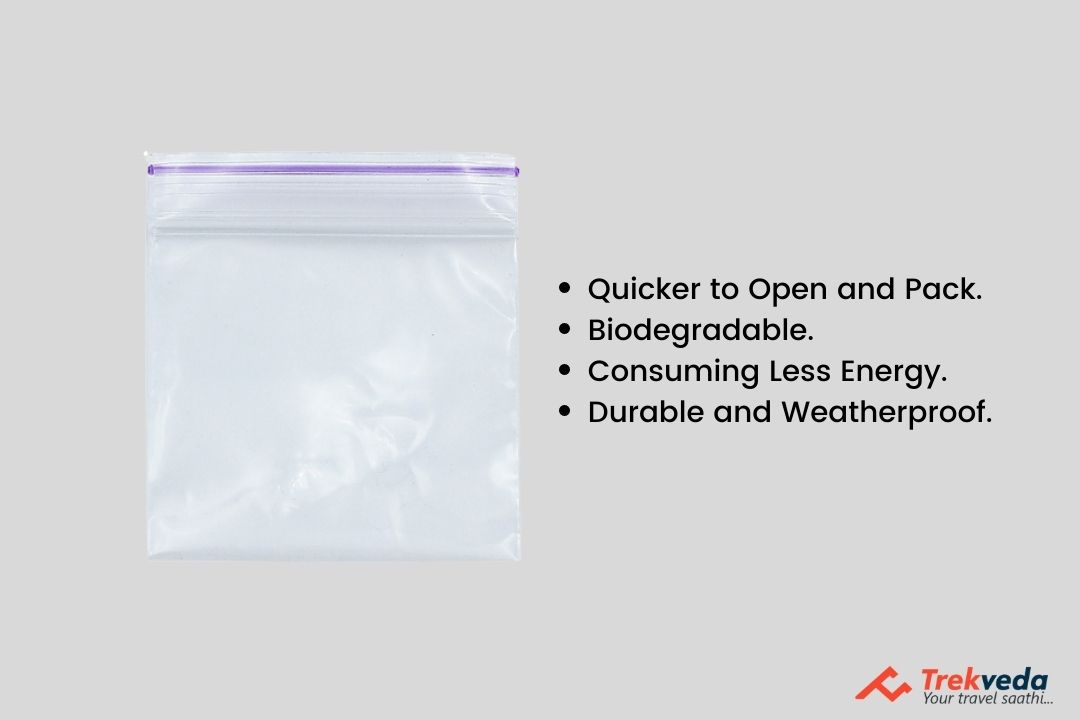
To keep everything organized, you should compartmentalize the stuffs into plastic zip bags and also carry a few in spare for wet clothes and other by-products.
Mandatory Documentation
There are certain rules and laws that you need to abide by, while going for the treks, however Trekveda takes care of all such kind paper works which is inclusive in the package. Certain registration fees and document verification along with some permissions are required in order to protect the nature and its evergreen heritage for future. In addition to this, if you need to avail a guide, you can also hire a guide with some bucks and a nominal paper work.
Please carry the documents mentioned below. Documents two and three need to be downloaded (PDF), filled in, signed and handed over to the trek leader at the base camp.
- 1 passport size photos and an original + copy of government photo ID document – required for Sanctuary registration and TIMS (Trekker’s Information Management System)
- Medical Certificate (first part to be filled by a doctor and second part by the trekker)
- Disclaimer form (to be filled by the trekker)
Measures Taken by Trekveda to Ensure the Security of Trekkers
Trekking is altogether a different kind of adventure where you required to be physically and mentally prepared for the best and adverse, all at once. With high altitudes making it tough to breath, the scenic beauty of those pristine mountains leave you spell-bounded so that you forget to breath for a moment or two. In addition to the physical and mental preparation, there are certain aspect of the health that are needed to be considered at the first hand when you make up your mind for the trekking,
Trekveda, by dint of its team of trained professionals, leave no stone unturned to provide you with the best trekking experience while ensuring your safety as its priority. Here are some vital aspects that Trekveda includes in its checklist to ensure the safety of its trekkers.
Criteria for Fitness Analysis
Trekking at high altitudes demands endurance and fitness and those who are prone to any kind of physical or physiological ailments are advised to not to go for high altitude treks in the beginning. To get assurance about the trekker’s fitness, we comply with certain aspects of the being fit such as BMI (Body Mass Index) along with the fitness proof since we can’t put the trekkers into the risk.
Acclimatization is another important aspect when it comes to getting an adaptation to the climate at the high range treks. A day at rest is not just the rest but a chance to get used to of the place and its habitat.
Monitoring the health is one thing that is conducted regularly during the trek by the trek leaders which includes the monitoring of your blood pressure, oxygen level and pulse rate. Details of your health during the trek is maintained in the health card on the regular basis. Health card can be collected from the trek leader at the end of the trek.
Medical Kit for High Range Trekking
An ideal medical kit that’s developed for the trekking has Blood Pressure Monitor/checker, Stature, Oxygen checker and Oxygen Cylinder coupled up with certain must have medicines, in case of medical emergency:
- Diamox
- Dexamethasone
- Dexamethasone
- Nifidipine
- Asthalin Inhaler
- Syringes
Trekking Equipment for High Altitudes
Trekveda provide you all the necessary equipment for trekking from tents to ropes. In addition to that, our trek leaders also ensure the safety by various safeguards they take time to time for your safety. Micro spikes are provided to attach to your shoes which help you to keep the traction on the snow and make it easier to climb. An additional gaiters are provided to cover the shows which prevent the entering of snow into the shoes. Customized tents are provided to the trekkers which ensure the warmth and temperature 10 degrees higher than the outside coupled up with high quality sleeping bags which can endure the temperature up to 15 degree Celsius below the freezing point.
Nutrition and Hydration
Trekveda, keep all your nutritional and hydration requirements on its checklist, our trek leaders will guide you to keep your body hydrated on the high altitudes as de-hydration can attract to the severe medical emergencies on high altitude treks.
We provide the highly nutritious meal to energize your body for the trek, however before certain long trails we ensure your nutritional requirements to be fulfilled with some high energy snacks or packaged lunch.
Make sure you keep up with your hydration and nutritional part as this can lead to some fatal consequences for your health.
In case of any symptoms you feel during the trek, don’t ignore or avoid them, immediately tell the trek leader.
Keeping up with the pre-defined processes and the guidelines will help you to have a memorable trekking experience.
What Trekveda has to offer in case of medical emergency like AMS, HAPE or HACE?
In case of medical emergencies, Trekveda and its trek leaders bear the sole responsibility to get you back to your wellbeing with their training and techniques. Suspecting any physiological disturbance in your body, immediately report to your trek leader as they are trained to counter such problems.
Problems like Acute Mountain Sickness can be prove fatal if not taken into consideration seriously on time. If you encounter/experience any of the symptoms such as persistent headache, fatigue or weakness, nausea, dizziness, loss of appetite, difficulty in sleeping, you shouldn’t let it go or treat it by your own either.
Acute mountain sickness is one of the most common yet the fatal problem trekkers face due to number of reasons, if the problem continues to persist, then you’re advised to descend down to the basecamp and then to visit the doctor immediately.
People with AMS are treated with number of medicines such Diamox, Nifidipine etc. coupled up with methods like Triple One Test- where one disprin is given with a liter of water along with the rest for an hour.
While AMS is most common at the high altitudes yet it can’t be risked taken casually as it leads to severe fatal conditions like HAPE (High Altitude Pulmonary Edema) or HACE (High Altitude Cerebral Edema) which, if not treated on time can lead to number of serious chronic disorders. These conditions need to not to comply with AMS, they can occur without AMS preceding.
It’s suggested to take every single disturbance into the consideration while you’re on the trek.
However, Trekveda is capable of tackling all the medical emergencies with its trained professionals yet there are several things that you need to consider, specially the intake of medicines and the knowledge about their advantages and side-effects. Don’t administer the medicine if you’re trekking through an organization, always seek help from the trek leaders, they are trained for such purposes, while in case of being a solo trekker, you should know about the medicines.
Keeping yourself hydrated and nutritionally fulfilled curbs the chances of AMS.
Risk and Response
A high altitude trek requires an audacious state of mind, however leaving on a bold excursion without computing the dangers is absolute idiocy. That is the reason we have recorded a couple of Risk and the Response arranged by Trekveda to limit or address the dangers in the most ideal way.
Risk: Altitude
Before you begin the trek, it is critical to comprehend the ramifications of high altitude on your body. Know about side effects of AMS (Acute Mountain Sickness) like mellow cerebral pain, queasiness and general distress.
Response: If you feel any of these indications, illuminate the trek pioneer on need and take after his directions. Each campground has as stretcher, completely prepared medical aid pack, oxygen chambers to address the circumstance.
Risk: Weather
Weather is unusual in the Himalayas. Despite the fact that we are constantly attentive about the evolving climate, nobody can ensure a snowfall, rain or Sun. Do comprehend that your security is of most extreme significance to us and we won't continue any further from the campground if the climate isn't ideal.
Response: The choice of the Trek Leaders and Guides to continue or sit tight for the climate to show signs of improvement will be last.
Risk: Injuries
Often, while trekking over troublesome territories, you may have minor wounds like leg sprain, wounds and so forth. Genuine wounds like breaks or real cuts are exceptionally uncommon.
Response: All our Trek Leaders are Certified Wilderness First Aid responders. They are prepared to deal with crises and can handle minor wounds with an all-around prepared medical aid unit. If there should arise an occurrence of genuine wounds, the patient is carried on a stretcher to the closest street head and is directed to closest therapeutic focus.
Risk: Lack of Communication
In the remote zones of the Himalayas, portable systems don't reach. On a trek, one is cut off from the universe of calls, SMS or WhatsApp Messages.
Response: We’d depend on walkie-talkies and sprinters to communicate between the campgrounds and the base camps.
Pre-Trek Preparations
Trekking, for its ever-lasting memories and experience, demands just a few things which involve physical endurance with physiological wellness. Not just the one who’s physically fit would do the magic in trekking but one also needs to be mentally fit as well in order to cope up with the adversities one might have to face during the treks such natural calamities, rains or other unforeseen conditions. To keep up with such requirements of trekking here are a few things you can do to get yourself physically fit.
Prerequisites of the Trek
Cardiovascular Endurance and Stamina
Cardiovascular endurance is the primordial thing that this trek asks for along with the stamina to withstand the stringent conditions during the trek. There are number of ways you can increase your endurance level but Jogging regularly with gradual increase in the pace would do the magic in just 2 or 2 and a half months. You can also increase your endurance and stamina through swimming, cycling and much more.
Combining the speed and distance target is the most effective way to get your body and mind prepared for the Trek. If you’re planning to build your stamina in a phased manner then here you should pay heed to:
- Target completing the distance of 5 km in 35 minutes or less at the beginning
- Pace up your legs to complete the 5 km in 30 minutes or less
- Before you begin the trek, you should be able to complete 10 km in 60 minutes or less
Strength
To build the strength is another most important thing and a major requirement for this trek. The whole journey of the trek is like an eternal staircase, the more you climb the better you can have the view. It goes with a climb followed by a flat then again, a climb followed by a flat. All the scenic beauty of the trek demands no less than the power of your legs.
The strength of your legs is something you need to work upon. Here is what you can do to strengthen your leg muscles to bear the pain of the trek.
Doing the squats can help. Goal for 3 sets of 15 repetitions without fail. You can begin with 8 squats in each set at the beginning, subject to your core strength for the exercise.
Flexibility
The more flexible you are the more you have the chances to get the glimpse with lesser hustle. Stretching is another major aspect of the trekking which provides you the much-needed flexibility to climb the altitudes with ease while carrying the backpack altogether is not an easier errand.
Stretching your body at large can bring you the utmost comfort during the trek. Here are some stretching you can do to get the flexibility-Stretch your hamstring, quadriceps, hip flexors, lower back muscles and shoulders. They’ll give strength and help you arrive on the slopes with the relaxed muscles. All these exercises would help you to get through the trek with ease and comfort provided you give an ample time to these.
Cardiovascular Exercise
Cardiovascular exercise is one of the most sought-after method which provide not just the physical endurance but also the strength to withstand any unavoidable circumstances sternly. Trekking demands the high endurance which you can develop in a month or two where you need to begin with the jogging or running (only if you could do). This practice needs to be combined with the speed and distance targets. You need to keep on increasing both with the time.
Begin with the small chunks of the targets and gradually increase for the bigger one. For instance,
Begin with a target of completing a distance of 5km. in 45 minutes and then gradually increase it to 7 km. in the same time and remain stick to this practice until you are able to cover 10 km. in 80-90 minutes without fail, at a stretch.
Strength Building Exercise
Another vital area of improvement, you need to work upon. Before you head to the trek, you need to have the physical strength in order to carry backpacks on the uneven terrains. Considering everything under the sun, you ought to prepare yourself for the core strength. A strength would be make you suffer less than others who’d not pay the heed.
Flexibility
Flexibility in the body is what the trekking demands the most. Carrying the backpacks without flexibility in your hamstrings, quadriceps, shoulder, lateral sides etc. can prove out to be fatal. More the muscles relaxed, easier would be your trekking experience. Carrying a backpack, however light in weight, can bring you the unnecessary pain which may spoil your entire trek.
Concentration
To pacify yourself or any other companion, yoga and meditation are the key. These practices not only give you the mental peace but also provide you with a placid inner conscience which is extremely important in order to withstand the cons during the trek.
This also improves your decision-making ability in the direst stressful situations, during the trek.
Terms and Conditions
Tour Payment Terms
Initial amount of 20% of the Invoice amount, the Client must pay the balance amount 15-20 days prior to the date of departure of the Tour.
Adventure Tours (Trek & Expedition) Payment Terms:
- INR 1500/- per person as an advance booking amount to confirm your adventure tour.
- Remaining amount of your booking will have to be paid 1 days before the date of travel.
Tour Amendments / Cancellations Policy
If the Client is willing to amend or cancel his/her booking because of whatsoever reasons including death, accident, illness, or any other personal reasons including non-payment of the balance payment, the Company is liable to recover Cancellation charges from the Client, as company had already paid your amount in advance in order to Guarantee your services.
For Adventure Tours (Treks & Expedition)
| Cancellation / Amendment notice received | Cancellation Charges per person |
|---|---|
| In case Trek is cancelled by Trekveda | 100% Refund will be provided if Trekveda Cancels the trek as per our refund policy |
| Upto 15 Days from the Trek date | 100% Voucher will be provided |
| Upto 8-14 Days from the Trek date | 70% Voucher will be provided |
| Upto 07 Days from the Trek date | 0% Voucher or Refund |
For Other Tours.
| Cancellation / Amendment notice received | Cancellation Charges per person |
|---|---|
| Up to 30 days prior to date of departure | Initial deposited amount |
| Between 15 days to 29 days prior to departure | 50% of tour cost OR Initial Booking amount whichever is higher |
| Less than 14 days prior to departure | 100% of Invoice Amount |
Note:-
- 100% Voucher will be provided if the trek/ tour is canceled due to unforeseen circumstances or any kind of Natural Calamities, Political Unrest, and Sudden Global Health Concern, Riots, Lockdown Government instructions etc. in this case Trekveda will issue you a voucher of respective amount having 1 year validity from Voucher date, which can be used in any trek of your interest operated by Trekveda.
- In case of any restriction/health issue (guest gets Covid +ve), we will be avoiding charging any cancellation basis documents been shared .The credit note for the same amount will be issued which guest can use in future.
Itinerary Policy
This itinerary is a sample itinerary based on the information available at the time of publication, all information given in this program Trekveda reserves the right to change any program information before or after your booking the tour due to any events beyond our control. In case if we are aware of any changes sufficiently in advance we will notify you at the time of booking, otherwise our Tour Manager or Local representative will inform you of the changes. Major road works or floods, landslides may necessitate route changes in the itineraries. All of these may cause us to make changes in the itineraries. The Company has mentioned the detailed itinerary, price inclusions & exclusions, special notes etc. in the pdf.
Activities Of The Itinerary
Trekveda is a travel and holiday organizers only, we do not control or operate any airline, neither do we own or control any shipping company, coach or coach company, Hotel, Transport or any other facility or service mentioned in this program. We take care in selecting all the ingredients in your holiday; but because we only select and inspect them and have no control in running of them, we cannot be responsible for mechanical fault or any injury, death, loss or damage which is caused by the act or default of the management or employees of any hoteliers, airlines, shipping company, coach owner/ Transport operator who are the company’s independent contractors arising outside our normal selection and inspection process.
Terms & Conditions:-
- There is no Contract between the company and the client until the company has received the initial deposit amount per person as specified for each tour package. The full payment must be received in accordance with procedures laid down under Payments Terms. If not paid in that time, the company reserves the right to cancel the booking with consequent loss of deposit and apply scale of cancellation charges as mentioned in the cancellation policy hereunder.
- The Company has the right at any time and for any reason:-
- To terminate the Contract after acceptance of the deposit but prior to the Commencement of Tour without assigning any reason whatsoever. In the event, the Company terminates the Contract, the company shall refund the initial deposit amount without payment of any interest.
- To amend, alter, vary or withdraw any tour, holiday, excursion or facility it has advertised or published or to substitute an Independent Contractor of similar class if it is deemed advisable or necessary. In either case, the Company shall not be liable for any damage, additional expense, or consequential loss suffered by the Clients or for any compensation claims made.
- The Company would be operating its Group Tours with minimum group strength of 6 adult passengers in each group. If the group strength falls below 6 passengers, the Company reserves the right to Pre-pone OR Postpone OR Merge or Cancel the group. If the Company cancels the Group Tour for any of the above reasons then the monies paid till then by Clients will be refunded against the receipt copies. It is clear understanding between either parties that any loss arising on account of cancellation of flight / train / bus tickets booked by the Clients; either through the Company or on his/her own or through a third party; the Company shall not be liable for such losses or additional expense, or consequential loss suffered by the Clients.
- No person other than the Company, in writing, has the authority to vary, add, amplify or waive any stipulation, representation, term or condition in this program.
- In the event of the Company exercising its rights to amend or alter any of the services as mentioned in the itinerary, after such tour or holiday has been booked, the Client shall have the right:
- To continue with the tour or holiday as amended or altered.
- To accept any alternative tour or holiday which the company may offer. In either of these above cases the Client shall not be entitled to, or the Company shall not be liable to the Client for any damage. Additional expense, consequential loss suffered by him or to pay any amount as refund.
- In case of any dispute, decision of TREKVEDA will be final and binding.
- TREKVEDA reserves the right to call you back on the contact number shared by you on the website.
- Any death personal injury, sickness, accident, loss, delay, discomfort, increased expenses, consequential loss and / or damage or any misadventure howsoever caused.
- Any act, omission, default or Independent Contractor or other person or be any servant or agent , employed by them who may be engaged or concerned in the provision of accommodation, refreshment, carriage facilities or service for the Client or for any person travelling with him howsoever caused.
- The temporary or permanent loss of or damage to baggage or personal effects howsoever caused In this condition the expression “Howsoever caused” includes negligence on the part of any person.
- No liability on the part of the Company arising in any way out of this Contract in respect of any tour, holiday, excursion facility shall exceed the total amount paid or agreed to be paid for the tour holiday, and shall in no case include any consequential loss or additional expense whatsoever.
- If the Client has any complaint in respect of the services provided by any of the Independent Contractors, the Client shall immediately notify the same in writing to the Independent Contractor and a copy thereof should be handed over to the Tour Manager of the Company in order to enable the Company to take up the matter with the Independent Contractor so that in future other Clients do not face the same difficulty.
- Any claim or complaint by the Client must be notified to the Company in writing within 07 days of the end of this holiday tour. No claim notified to this Company beyond this period will be entertained and the Company shall incur no liability whatsoever in respect thereof.
- Each of this condition shall be severable from the other end if any provision be invalid, illegal or unenforceable. The remaining provisions shall nevertheless have full force and effect.
- Insurance: The tour cost does not include any costs towards the Travel / Meclaim Insurance premium. In case if the Client needs an Insurance coverage, it is suggested to go for suitable insurance policy on your own. The Client has to deal directly with the Insurance Company in case of settlement of any claim.
- Change in Tour Price: The tour prices printed / advertised / quoted to Client are dynamic prices. The person booking tour early is likely to get the lowest price as communicated / offered by the Company, subject to availability of seats. Similarly, person booking tour at the last will be offered the highest prices. This pricing module has been adopted to get early bookings on tours. Hence it is quite obvious that persons travelling on a same group tour are likely to have paid different tour prices. The Company will not entertain any claim whatsoever on account of the same. Also it is clear agreement between either parties that the prices quoted in the proposal / brochure have been calculated based upon the prevailing hotel / transport tariffs and applicable taxes thereon at the time of printing this brochure. The Company reserves the right to amend the price published in this program in case of costs increased before the date of departure. All such increases in price must be paid for in full before departure by the Client. The company also reserves the right to charge offer time to time as per the present situation demand / circumstances.
- Force Majure:-Acts of god (including exceptional adverse weather conditions), earthquake, fire , war (declared or undeclared), invasion, rebellion, revolt, riot, civil commotion, civil war, nuclear fission, Lockdown, strike, act(s) of omission/commission by any concerned government(s), or government agencies, judicial or quasijudicial authorities, occurrence of any event can force the Company to change or extended. Hence any additional expenditure occurred due to the above reasons the same will be borne by the passengers.
- Please note trekking / driving time given in the program are approximate and it may vary due to break for refreshments, photography, bad weather and Road conditions
Health & Safety: The Company shall in no circumstances whatsoever will be liable to the Client or any person traveling for:
Meals
The menus are pre – set menus provided for breakfast/lunch/dinner on the tour as mentioned under each Tour itinerary and inclusions as printed in our brochure. The meals will be served at restaurants of hotel of stay. The enroute meals or meals during excursions could be packed meals or served by enroute/local restaurants / Dhabas. We cannot process a special meal nor do we guarantee the special diet to the customer. We however reserve the right to change the meal arrangement if circumstances make it necessary to do so. If a tour participant does not avail his/her meal in stipulated time; he/she has to avail the meal on his/her own arrangement and expenses. No claim can be made for the meal which he/she has missed and not utilized.
Itinerary Changes
For the comfort and convenience of our clients, we will sometimes reverse the direction, or slightly amend the itinerary. We will try to advise you of these amendments, prior to the start of the tour or on tour. In the event that a tour participant misses on any part of the sightseeing tour or any such tour due to delay on his part, he will not be entitled to claim refund of the same.
Hotel
We have mentioned the indicative names of the Hotels for each tour. We reserve the right to change the same due to unavoidable circumstances. In that case we may provide alternative, similar accommodation for which we are not liable to pay any refund. We will not be responsible or liable in case of loss of property or life at the Hotel. Similarly any damages caused to the hotel rooms during your stay, shall be payable by the Clients and the Company will not be liable for the same.
Transport / Coach / Sitting
We use Deluxe 2 X 2 Coaches or vehicles such as Tempo Traveller, Tata Winger, Chevrolet Tavera, Mahindra Scorpio, Toyota Qualis, Tata Sumo or similar as per the availability of vehicles and actual size of the group. Our tour manager / local representative will take reasonable care of your luggage but if you are carrying any high value items on the coach, we advise you not to leave them behind when you leave the coach. We will not be responsible or liable in case of theft or robbery of the said items from the coach. All baggage and personal effects are at all times and under all circumstances your responsibility. Any damages caused to the hotel rooms / coach during your stay, shall be payable by the Clients and the Company will not be liable for the same. The drivers of the vehicles are bound by specific rules like maximum driving hours within a day/during a week, rest period per day/week etc. Clients will have to strictly adhere to the prescribed timetable for the day so that the driver can complete the travel. In case, any of the sightseeing schedules is missed due to delays caused by the client, the same will not be refunded to the client under any circumstances. Please note that AC will not work in Hills and no claims to this regard shall be entertained.
Risk and Liabilities - Clients shall agree that Trekveda shall not be held responsible for consequences of natural calamities, weather condition, failure of scheduled airline, detention and delays due to quarantine, strike, theft, force major, civil disturbance, government restriction or regulation, accident by aircraft, car, bus or any other form of transport relating to program schedule. The travelers understand that such situations may occur, and we will inform you of the situation as soon as we have knowledge of it. The right is reserved to cancel or alter any package as conditions require, all additional cost occurs in such case will fully be borne by the travelers. Also, Trekveda shall not be held responsible for any loss/damage of your personal belongings.
Note:-
Basics
- Price is subject to change without any prior notice.
- Price is based on the “Base” Category of Hotel Room; this is Irrespective of the Package Category Chosen. Upgrade to Higher Category is available at an extra cost.
- All domestic Hotels/Transport rates are based on current tariff & subject to change without prior notification; the revised rates will be charged extra.
Hotels
- Many regions do not have star category hotels. Generally there isn’t any star categorization in this sector, however the same is demarcated as per prices and put into slabs of 2*/ 3*/ 4*or STD/ DLX/ PRM or equivalent.
- Quote based on Non-Ac Rooms in Hills. AC Rooms on Extra Charges.
- Please be reminded that all special requests like early check-in, smoking, non-smoking, views, floors, king, twin, adjoining and/or interconnecting rooms are strictly subject to availability upon arrival and cannot be guaranteed prior. Any expenses arising out of this is to be borne by the customer.
- Only 01 extra bed/mattress is allowed per room. This extra bed means a Mattress / Roll over Extra mattress on floor provided where proper extra bed isn’t available.
- In case of guests cannot climb the higher floors, we request you to update this at the time of booking so that we may take appropriate action and try for rooms in the Ground floor. This is again subject to availability and difference if any will have to be settled directly before check out.
- There will not be any refund in cased any of the sightseeing is missed/uncovered during the trip.
- In hills, hotels may be located in a way where the view might be of a building in the front, beside or behind it.
- The Hotels may/may not have some of following amenities as per its policy. Tea/coffee maker/ mini fridge/ enhanced toiletry kit (with moisturizer, tooth paste, brush, shaving kit, lufa, bathroom sleepers, bath-robe) etc.
- For meal plans, menu will be on fixed plan/ buffet basis and not on A-la-Carte basis. MAP & AP Meal plans do not include Evening snacks & cold drinks / liquor, Soups or Deserts. For order on A-la-Carte basis, guests are requested to make direct payment for additional items.
Incidental charges due to unforeseen situations
All arrangements made by Company are in the capacity of an agent only. Company will not be liable for claims or expenses arising from circumstances beyond our control such as accidents, injuries, delayed or cancelled flights & acts of Force majeure/ traffic jams / traffic halts/ diversions/ bandh/ curfew, Union strike, VVIP movement, etc. – We will request you to bear with us the situations beyond our control. We will arrange for alternate sightseeing. In case of discontinued itinerary due to these reasons no refund on the hotel booking will be provided and alternate accommodations (as per availability) are managed in the place where you have to stay back. While it is our endeavor to manage the alternate arrangements during such scenarios, please note the difference may be charged for the same.
1. Is Chadar trek suitable for the Beginners?
Chadar trek is graded as difficult trek with an altitude of 11,100 Ft. A beginner can’t opt for Chadar trek.
2. Where Chadar trek is situated?
The trek starts from Leh Ladakh, a union territory of India.
3. What is the physical fitness requirement for Chadar trek?
Chadar is a difficult trek. Hence, not recommended to the beginners, only those can hit the trail to Chadar trek, having experience in Himalayan treks before. Mental & Physical fitness has equal importance in this trek. A trekker needs to start yoga along with weight lifting exercises with meditation so that strength, stamina and strong mind and make you lead the trek.
4. What is the best time to do Chadar trek?
Best time for the trek is between mid of January and early February.
5. What is an age limit for Chadar trek?
The age limit for Chadar trek is between 12 to 15 years.
6. Which mobile network works in Chadar trek?
Chadar trek nestled at an altitude of 11,100 Ft. which is inaccessible for any mobile networks. So, it would be better to inform your family earlier in Leh only.
7. Is there any risk of wild animal or avalanche in Chadar trek?
There are chances of Avalanche in Chadar trek; therefore, it is advised to not go beyond your trekking group. However it is informed earlier about the weather forecast.
8. Is liquor and smoking allowed in Chadar trek?
No, Liquor and smoking aren’t entertaining in Himalayas, for your own health where people get easily sick of high altitude. Having liquor in Himalayas is not at all advisable and smoking? A big no, because one needs fresh oxygen to trek, therefore smoking is like a Trauma.
9. What is a trek distance of Chadar trek?
Chadar trek distance is 62 Km.
10. Is Chadar trek hard to Conquer?
No, the trek is not hard to conquer; anyone with decent fitness and have at least an experience of Himalayan treks before.
11. Chadar Trek Temperature?
-5 to -15 degrees (during the day) and -15 to -25 degrees (during the Night).
12. What is the best time to go to Chadar Trek?
January and February.
Send me detailed itinerary on my whatsapp no. 
Recommended Treks
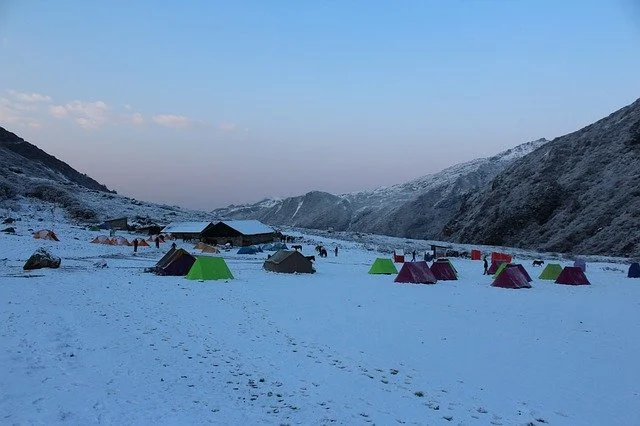
Goechala Trek
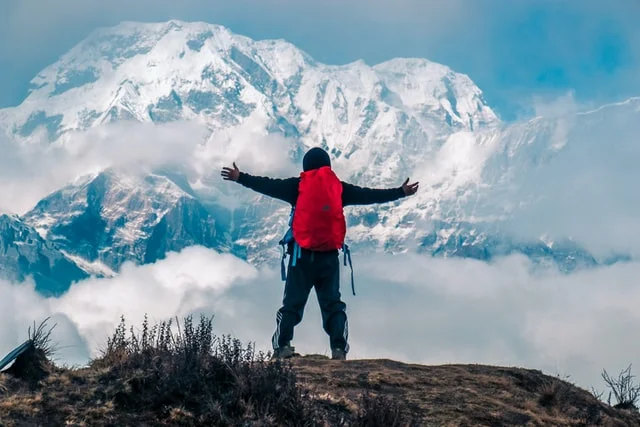
Annapurna Base Camp Trek
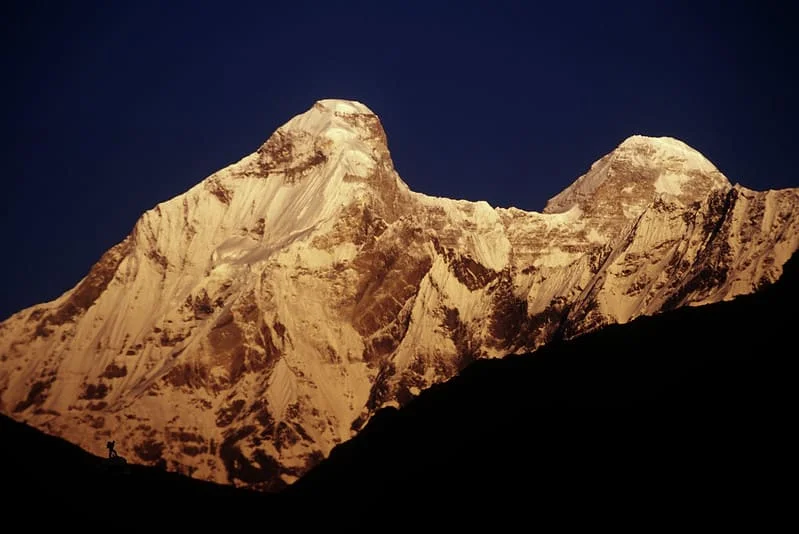
Nanda Devi Base Camp Trek
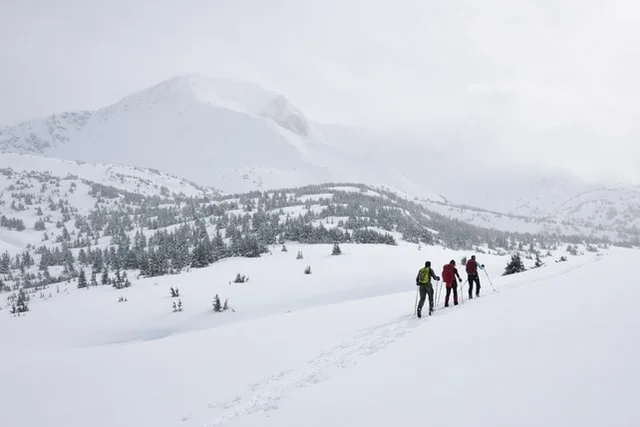
Pin Parvati Pass Trek
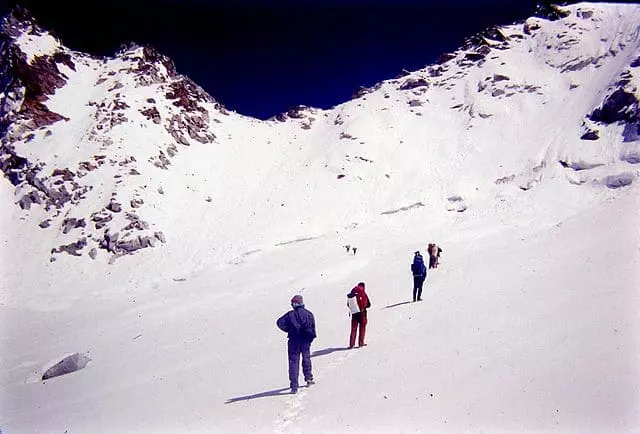
Borasu Pass Trek
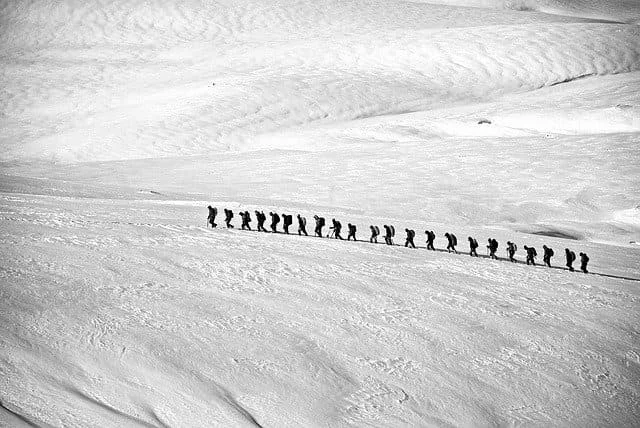
Lamkhaga Pass Trek
